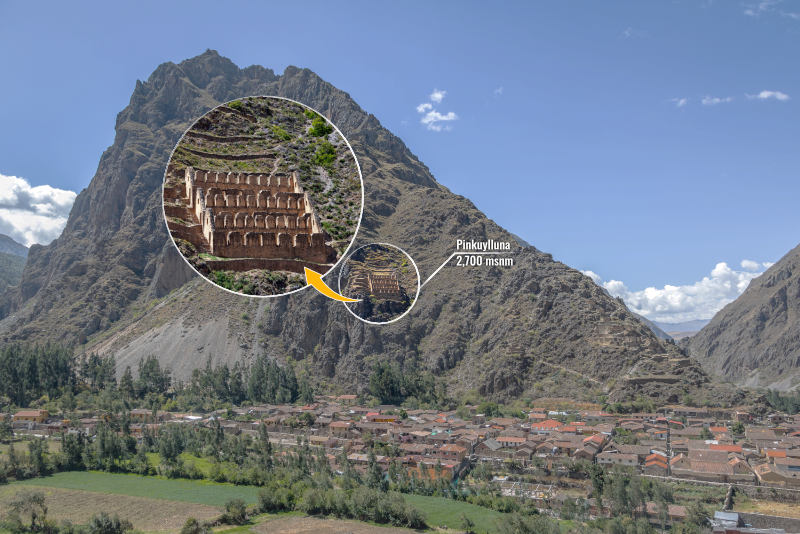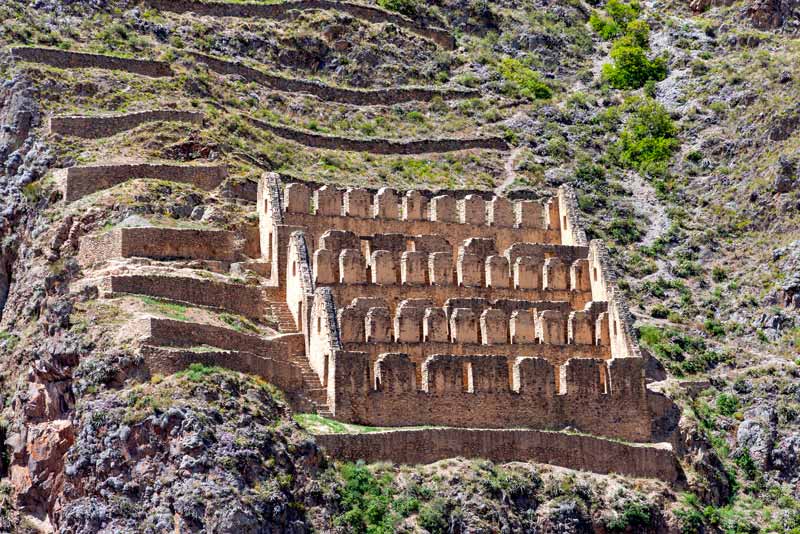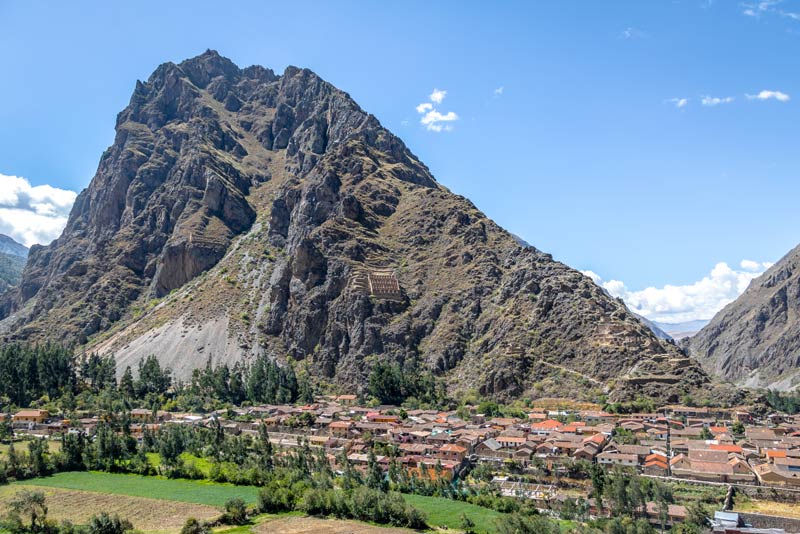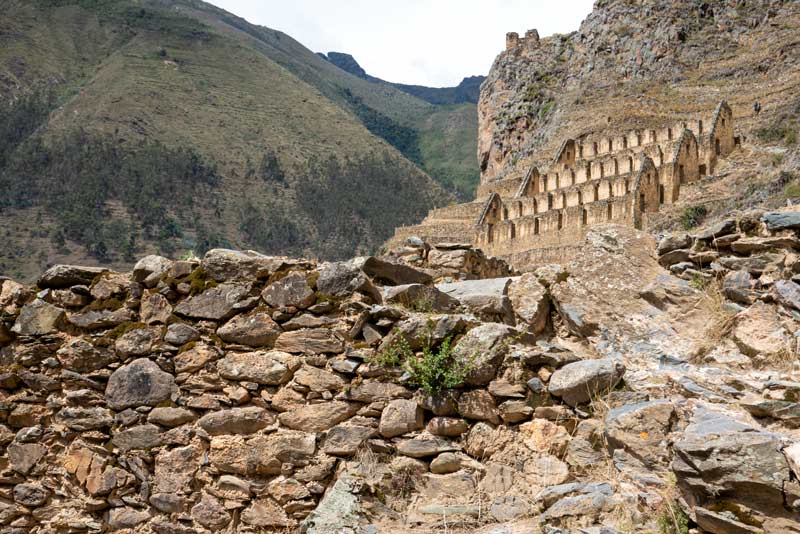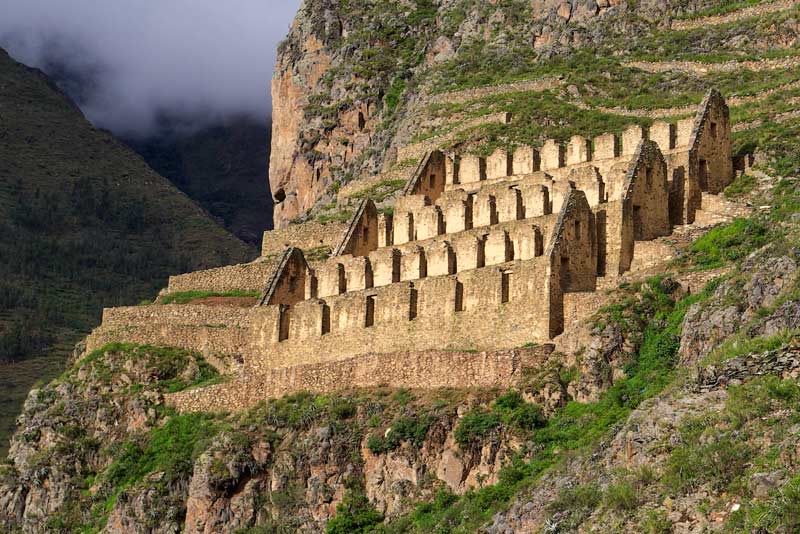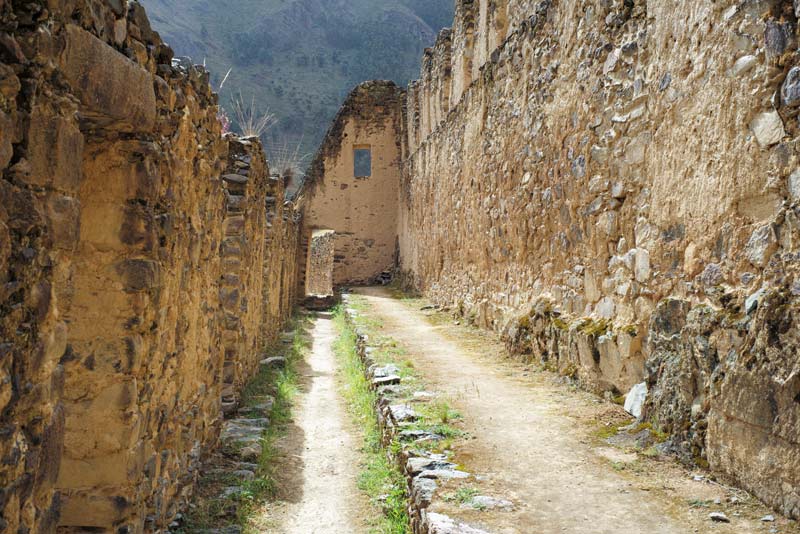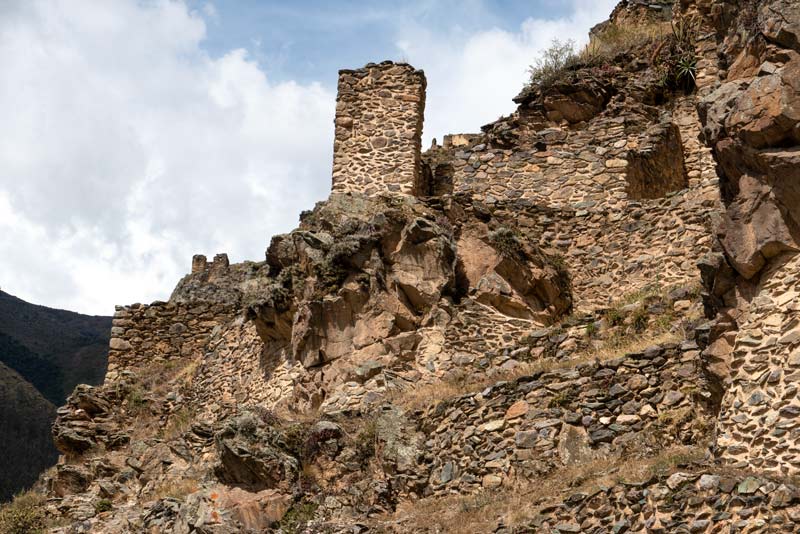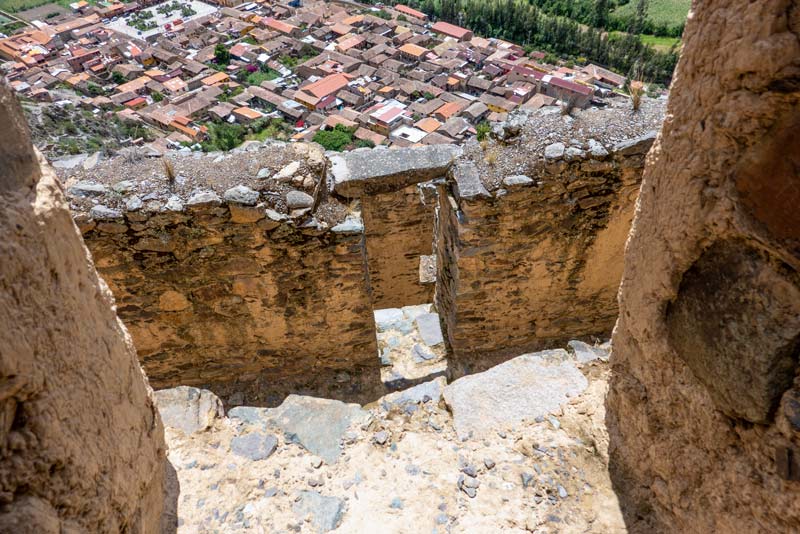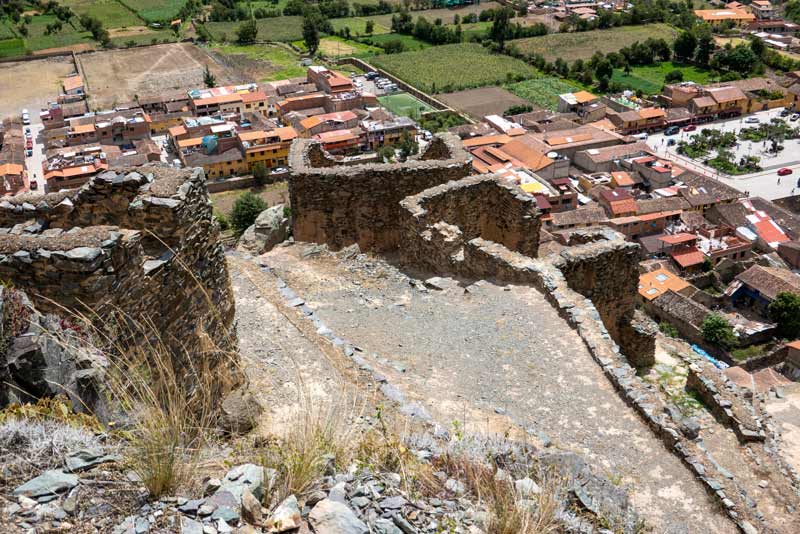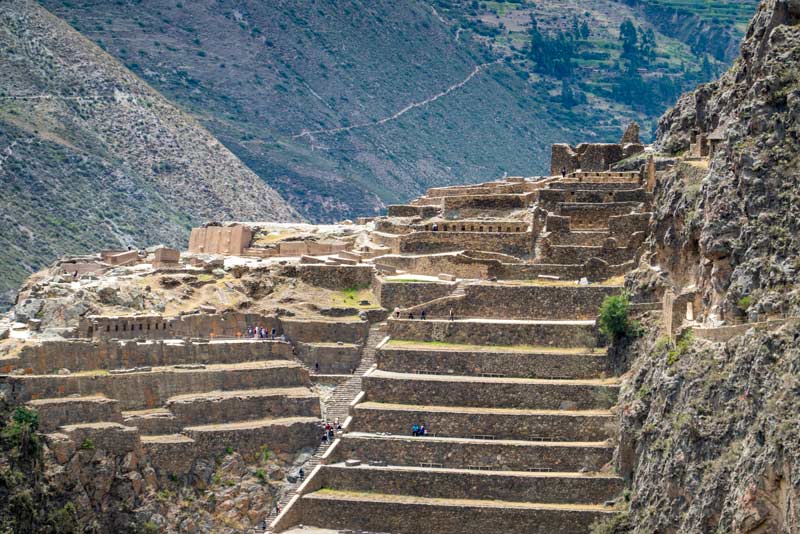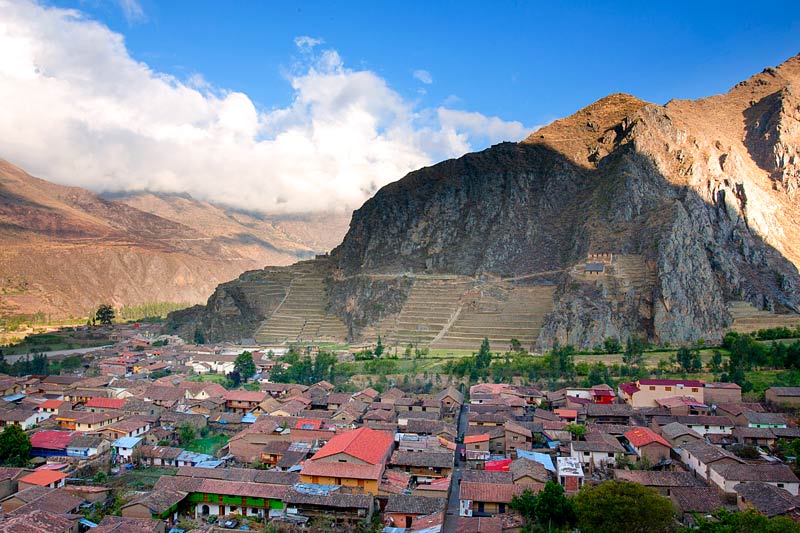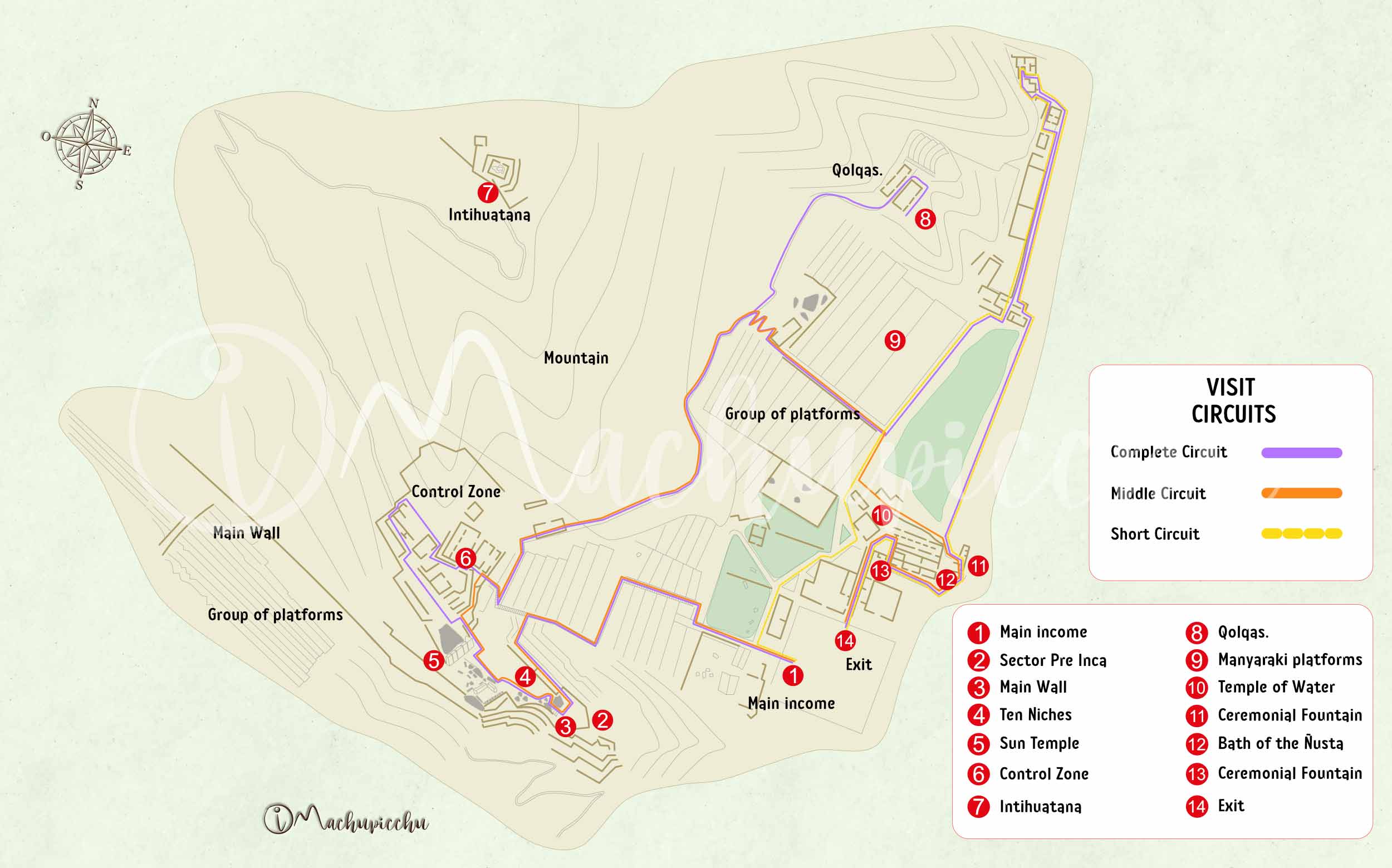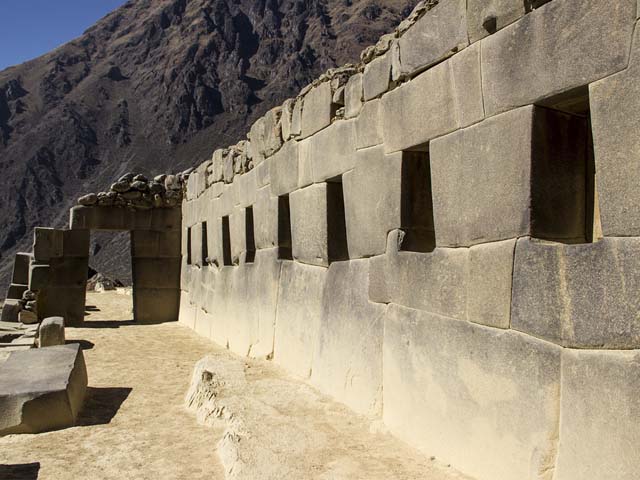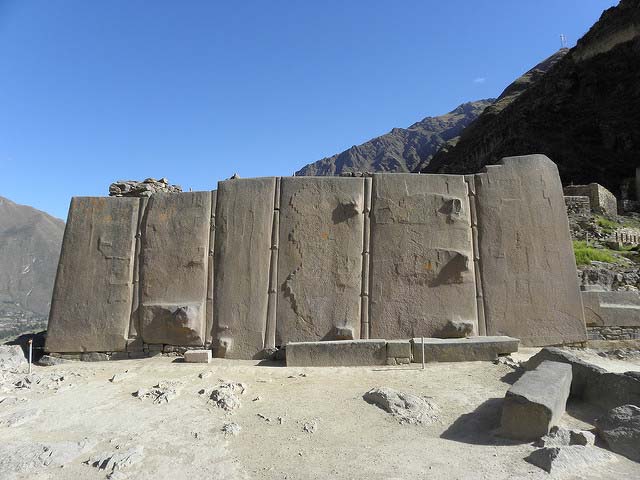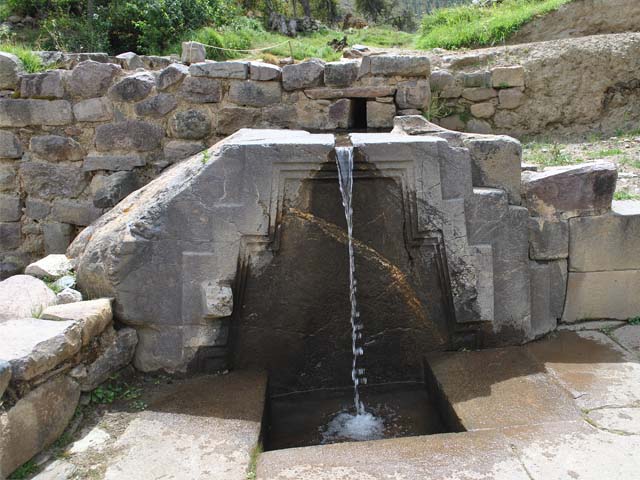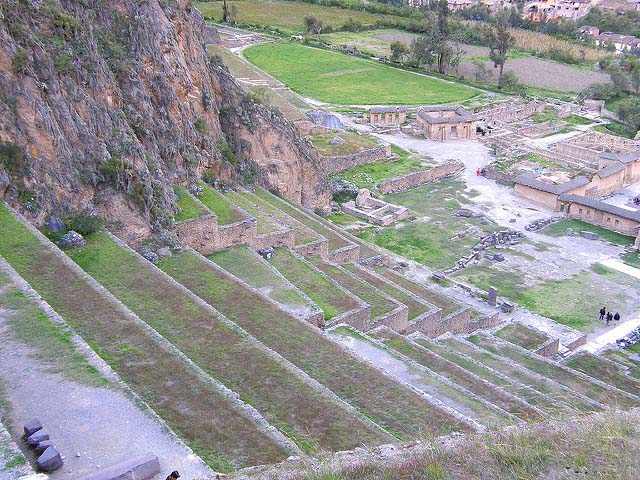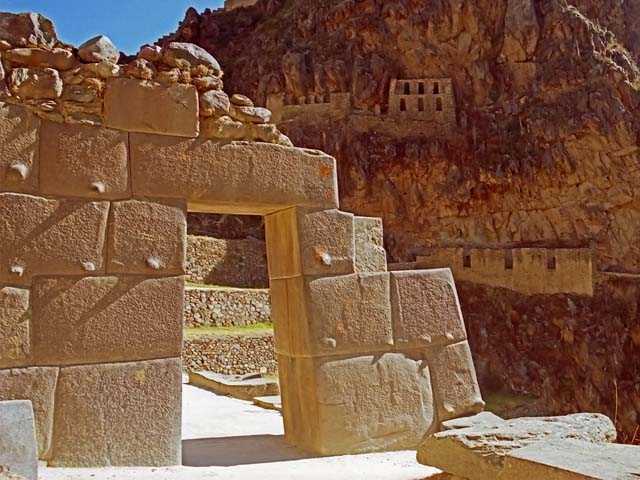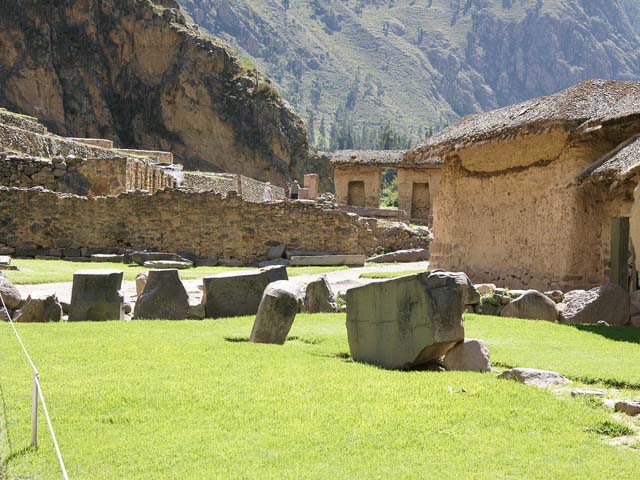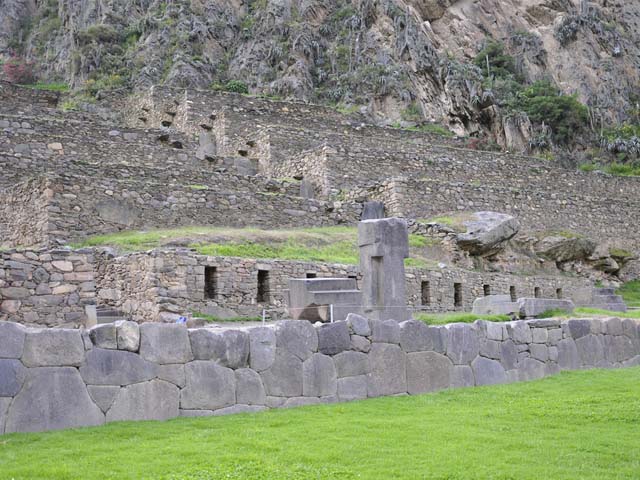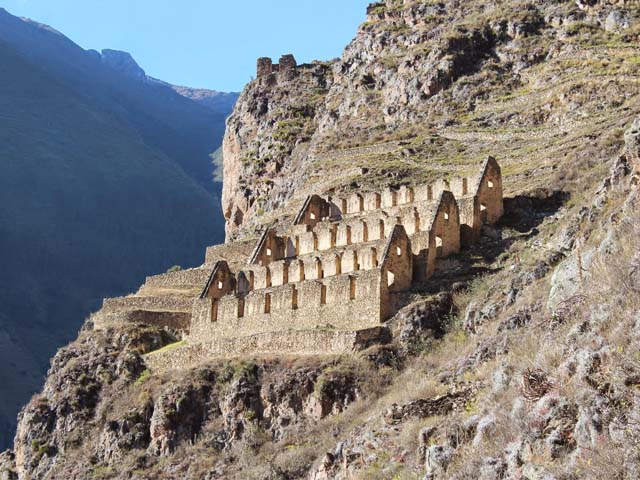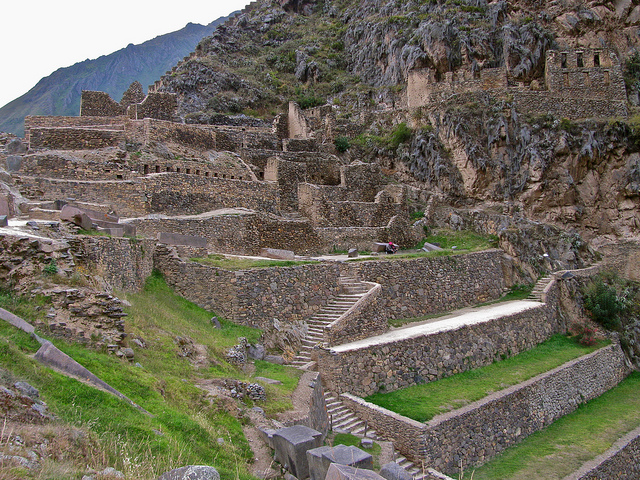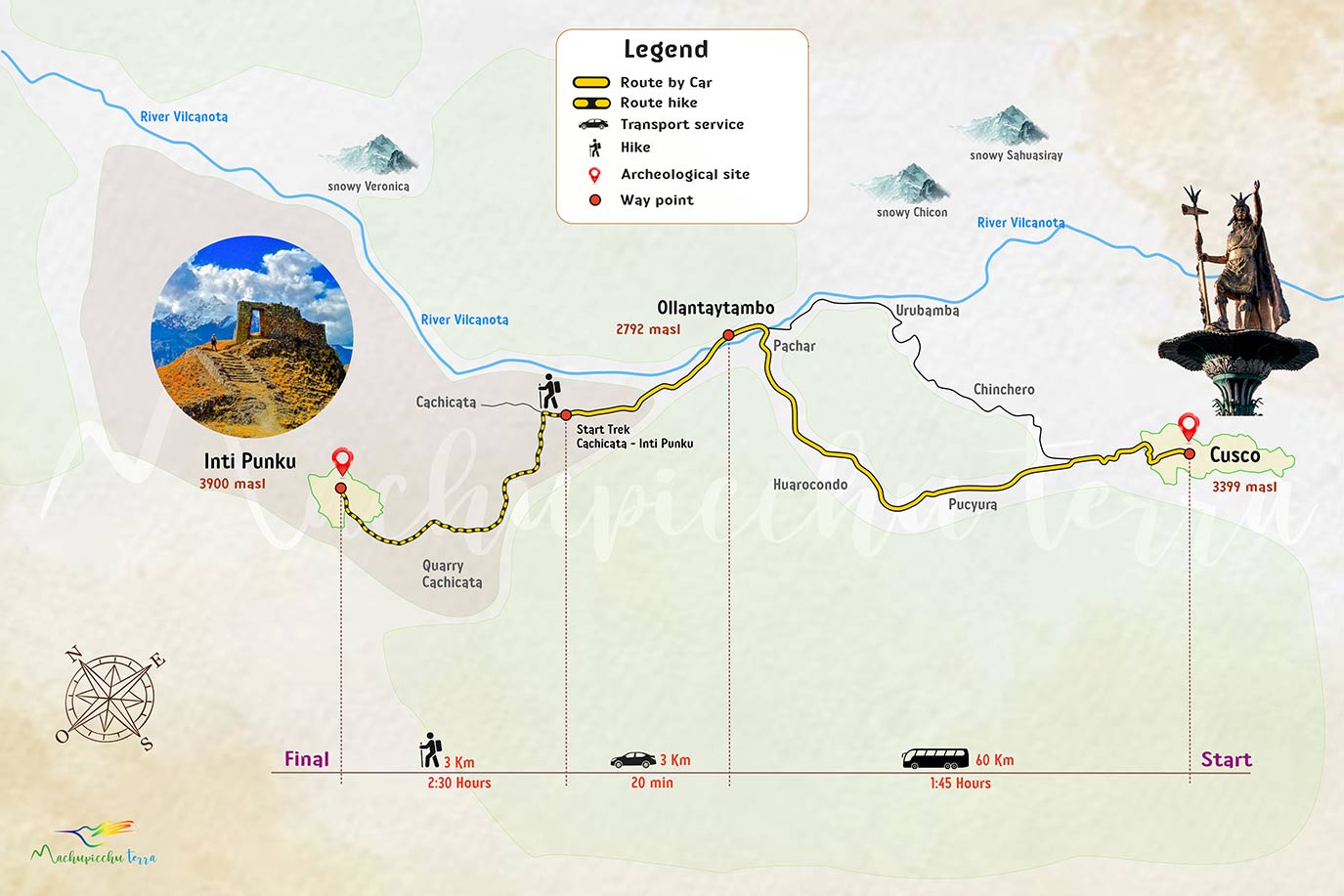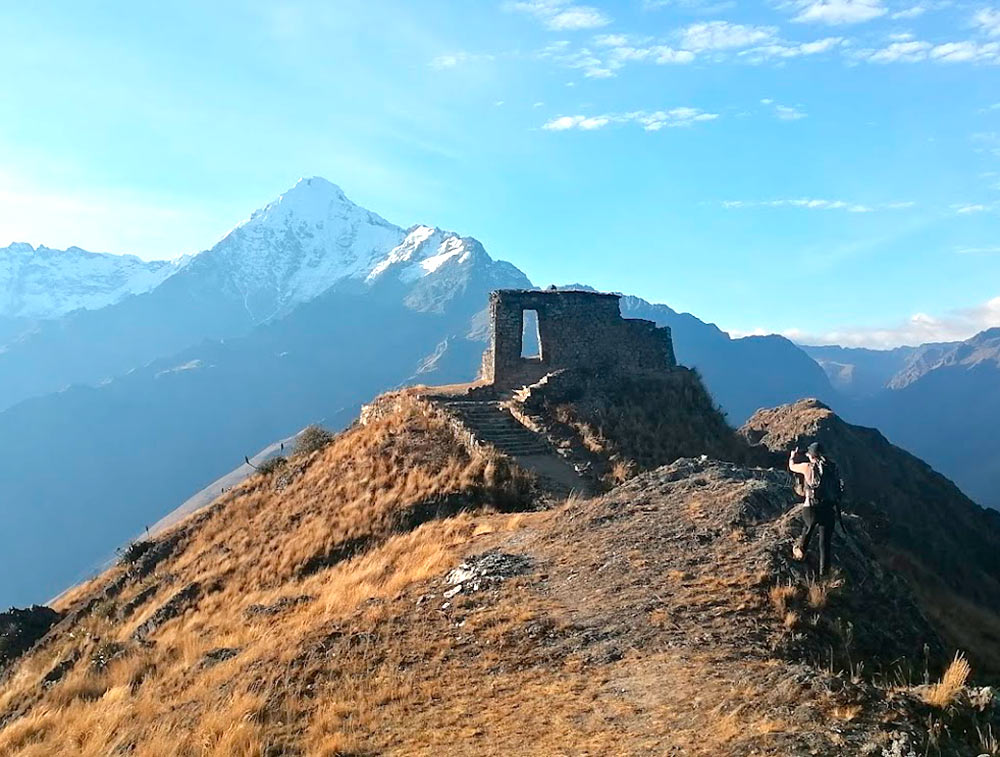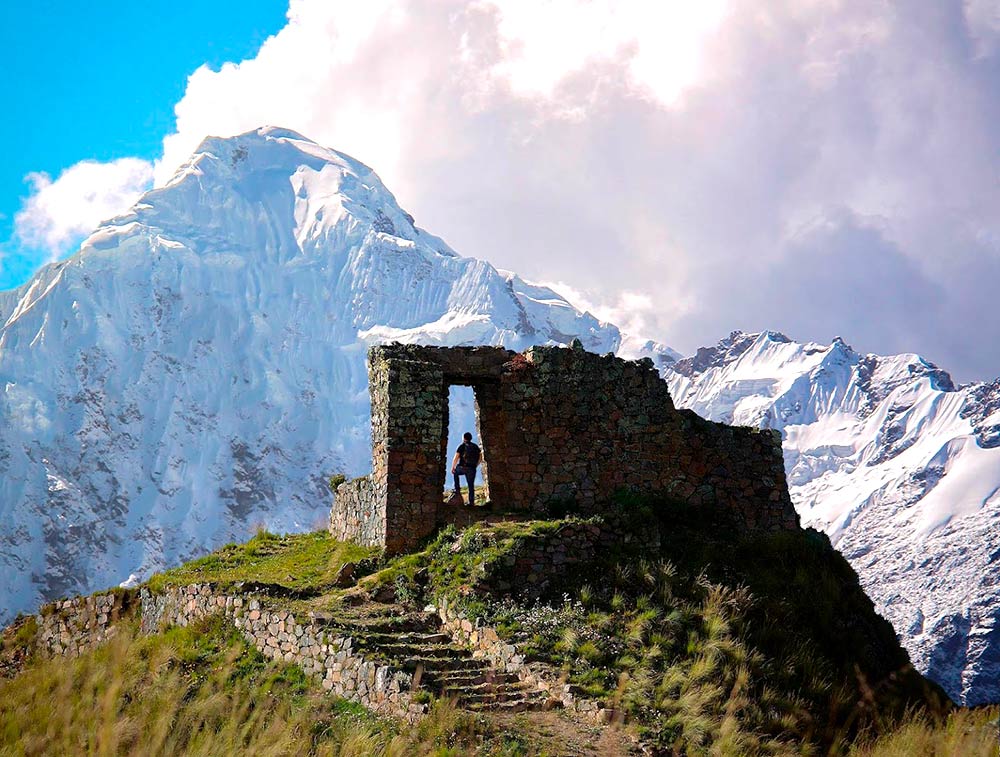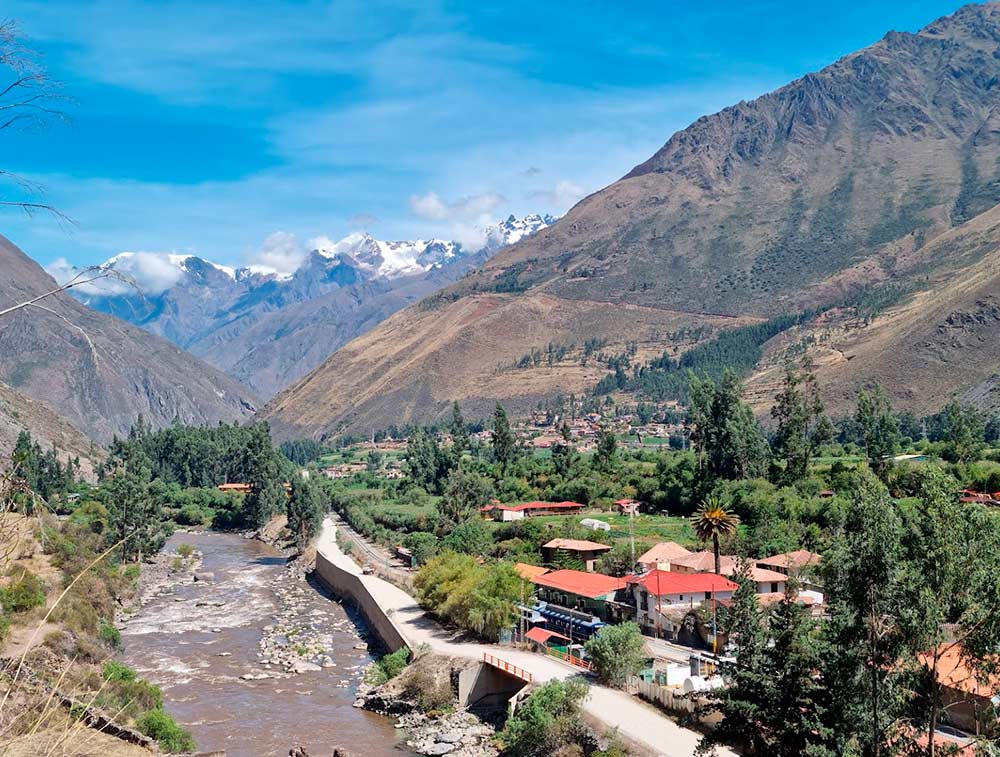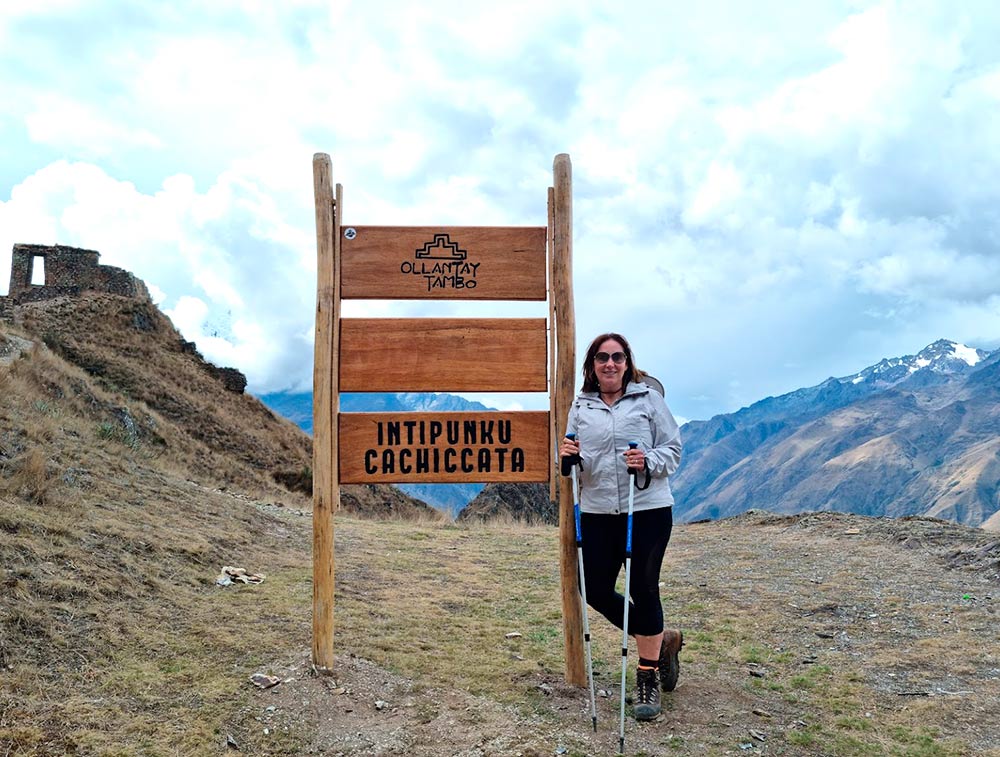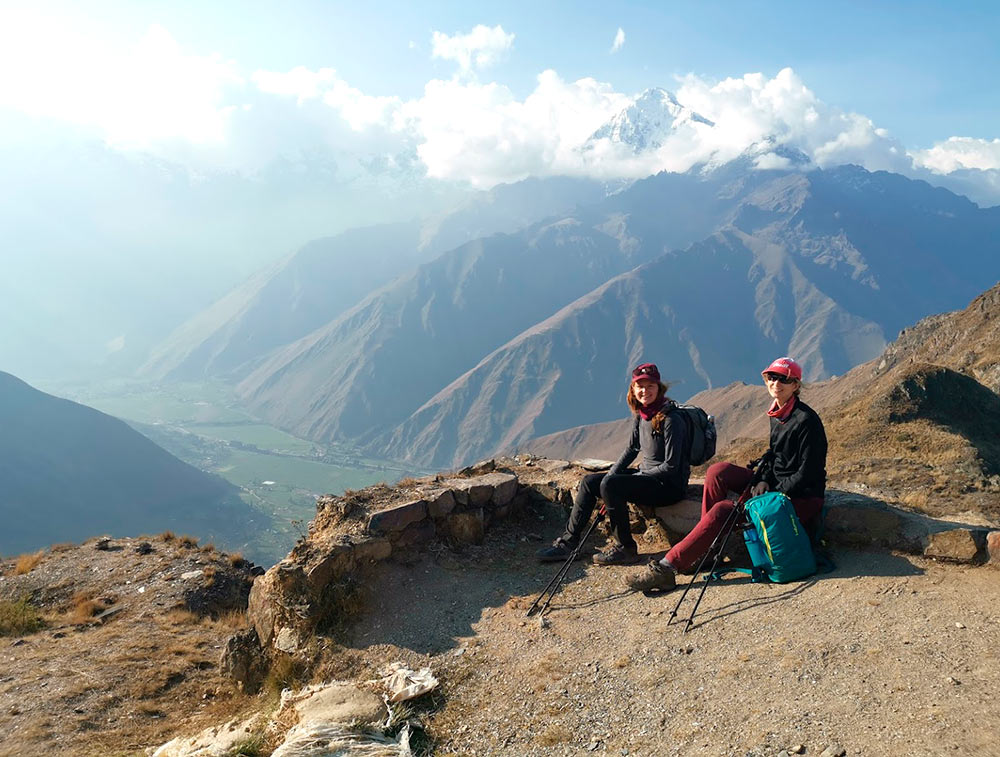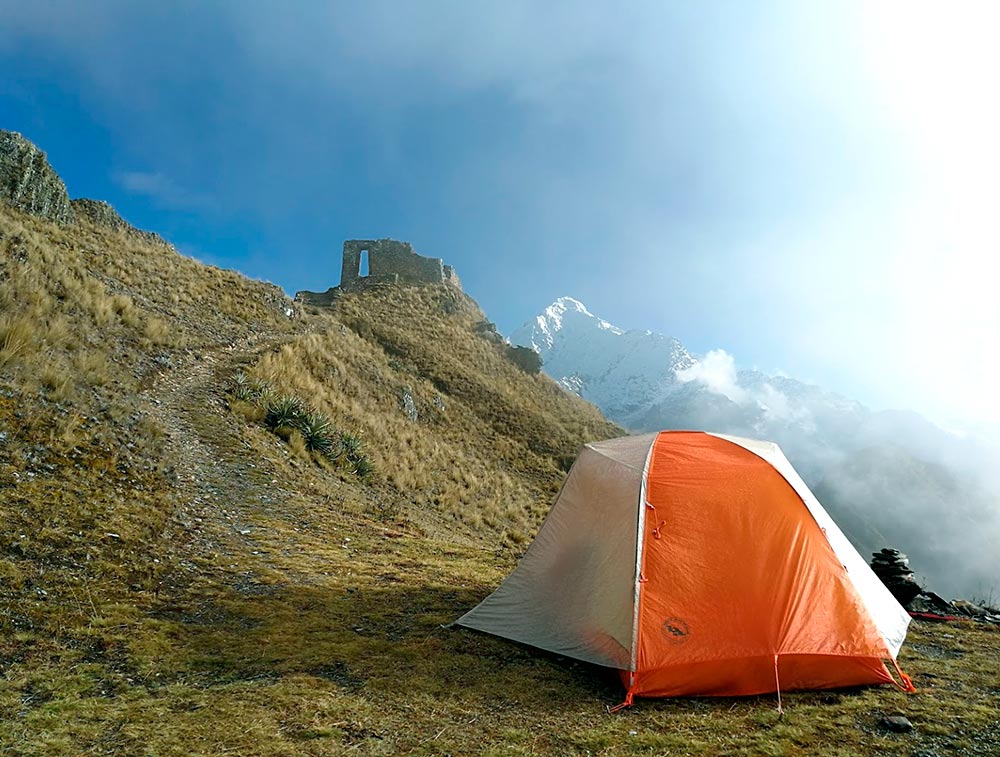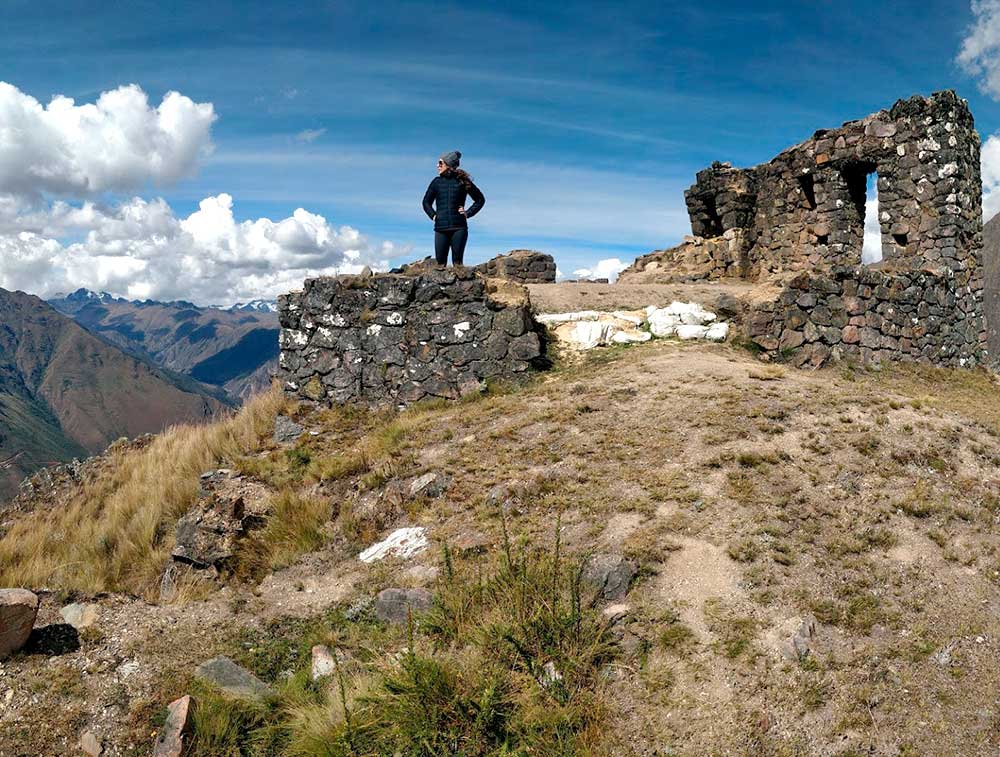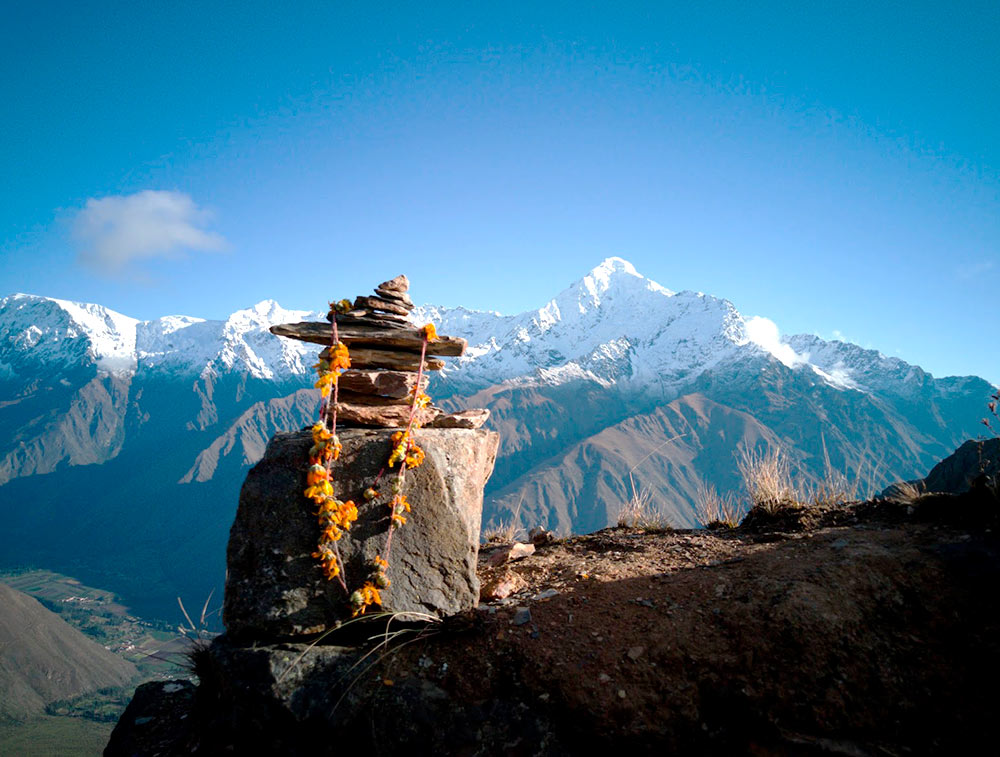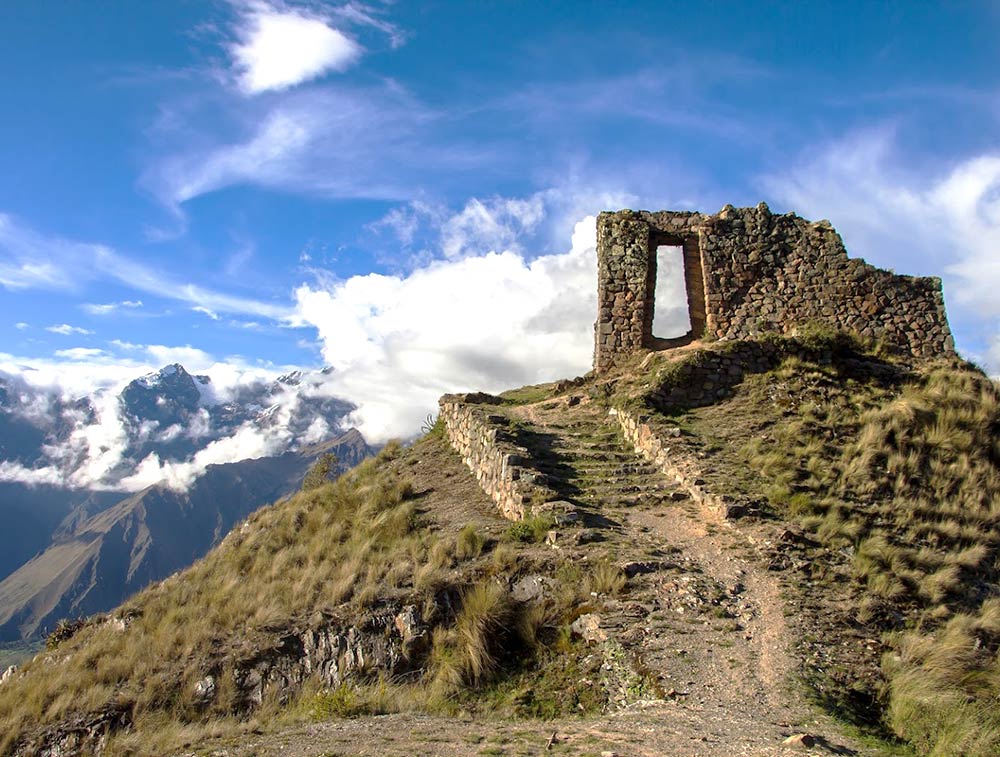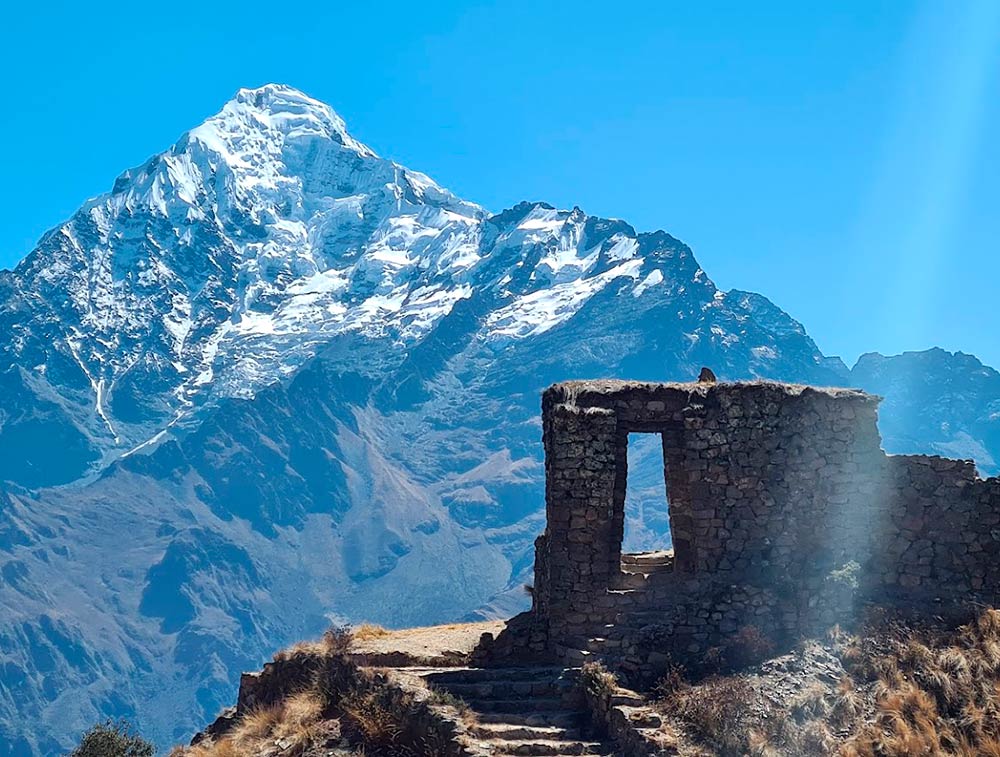The post The Fortress of Pinkuylluna in Ollantaytambo first appeared on Ticket Machu Picchu.
]]>Pinkuylluna is an archaeological site located in the heights of Ollantaytambo, known for its impressive fortress and panoramic views of the Sacred Valley. The structure, dating back to the Inca period, is a mix of defensive and religious architecture, with a purpose that is still not completely understood but likely related to the protection and surveillance of the area.
- What will I find in Pinkuylluna?
- Where is Pinkuylluna located?
- How to get to Pinkuylluna?
- Features of the Pinkuylluna archaeological complex
- What does Pinkuylluna mean?
- Comparison: Pinkuylluna archaeological complex vs Pisac
- What was the function of the Pinkuylluna archaeological complex?
- What other places can I visit on my trip to Pinkuylluna?
- Image gallery: Pinkuylluna
- Recommendations
- Frequently asked questions
What will I find in Pinkuylluna?
In Pinkuylluna, you will find a fascinating blend of Inca architecture, nature, and stunning views.
- The Fortress Ruins: At the top of the hill, you can explore the ruins of an ancient Inca fortress. While its exact function is not fully known, it is believed to have served as a watchtower and defense post. The stone walls, carved with great precision, are integrated into the rock, showcasing the Inca’s architectural skill.
- Panoramic Views: From the top of Pinkuylluna, you will have spectacular views of the Sacred Valley, with views of the city of Ollantaytambo (How to get to Ollantaytambo), agricultural terraces, and the mountain peaks surrounding the area. It’s an ideal place for photography or simply enjoying the tranquility of the natural surroundings.
- Challenging Hiking: Accessing the fortress involves a steep hike through a rocky trail, adding an adventurous touch to the visit. As you ascend, you will have the opportunity to observe local flora and fauna, and the effort will be rewarded with an incredible view at the end of the hike.
- Chambers and Tombs: At the top of the site, you can find what appear to be ceremonial chambers, some tombs, and spaces that archaeologists believe were used for religious or funerary rituals. These remnants give us a glimpse of the spiritual significance the place held for the Incas.
- Low Crowds: Unlike other nearby sites, Pinkuylluna is not as well-known, so you will generally have a more peaceful experience, allowing you to feel more connected to the history and surroundings.
Where is Pinkuylluna located?
Pinkuylluna is located in the town of Ollantaytambo, in the Sacred Valley of the Incas, in the Cusco region. It is about 70 km from the city of Cusco, approximately 1.5 hours by car.
The Pinkuylluna fortress is situated on a hill just north of the town, near the famous Ollantaytambo ruins. Access to the site is through a steep trail that leads visitors up to the top, where the ruins are located.
It is a perfect destination for those in Ollantaytambo, as it is very close to the town’s main square and is a great complement to the visit to the other more famous ruins in the area. Additionally, the location of Pinkuylluna allows for panoramic views of the town and the surrounding valley.
Don’t rush when you reach the top; take a few minutes to enjoy the stunning views of the Sacred Valley. From Pinkuylluna, you can appreciate a unique panorama of Ollantaytambo and the surrounding mountainous landscape, which is perfect for taking photographs.
How to get to Pinkuylluna?
-
1. From Cusco to Ollantaytambo:
- By car or taxi:
- The journey takes about 1.5 hours and covers a distance of 70 km.
- You can take a taxi or private transport from Cusco. At the Cusco bus terminal, you will also find options for transport to Ollantaytambo.
- By bus:
- Several transport companies offer regular trips to Ollantaytambo. The buses depart from the Cusco transport terminal, and the trip takes about 2 hours.
- By car or taxi:
-
2. From Ollantaytambo to Pinkuylluna:
- Once in Ollantaytambo, Pinkuylluna is only about 10-15 minutes on foot from the town’s main square.
- To get to the site, you must walk along a steep trail that starts near the entrance to the Ollantaytambo archaeological complex. The path is somewhat challenging, but very rewarding due to the panoramic views that can be enjoyed during the climb.
- The hike to the top takes between 30 to 45 minutes, depending on your pace. At the top, you will find the ruins and can enjoy spectacular views of the valley.
Features of the Pinkuylluna Archaeological Complex
| Feature | Detail |
|---|---|
| Location | Ollantaytambo, Sacred Valley, Cusco region, about 70km from the city of Cusco. |
| Access | On foot from the main square of Ollantaytambo, about 15 minutes walking. |
| Altitude | Approximately 2,700 meters above sea level. |
| Area | Small area, the site is located on a hill, at a high altitude. |
| Climate | Temperate climate, with sunny days, windy afternoons, and cool nights. Rain is more frequent between November and March. |
| Flora and fauna | Andean mountain flora, such as ichu. Local fauna includes birds and rodents. |
| Conservation conditions | Well-preserved, though some structures have been eroded over time. |
| Accessibility | The trail to Pinkuylluna is steep and rocky, considered of moderate difficulty. |
| Visits and tourism | Less crowded than other nearby sites, such as the main Ollantaytambo archaeological complex. |
What does Pinkuylluna mean?
The name Pinkuylluna comes from Quechua, and its meaning is related to the term “pinkuyllu,” which refers to an Andean wind instrument similar to a flute.
Possible interpretations:
- Place of the pinkuyllu: The term could refer to a space associated with music or ceremony, where the pinkuyllu instrument played an important role, possibly during rituals or spiritual activities in Inca times.
- Sound of the wind: It is also associated with the sound of the wind passing through the structures and mountains, resembling the melodic whistle of a flute, which might have inspired its naming.
Comparison: Pinkuylluna Archaeological Complex vs Pisac Archaeological Complex
| Aspect | Pinkuylluna Archaeological Complex | Pisac Archaeological Complex |
|---|---|---|
| Location | Ollantaytambo, Sacred Valley, Cusco. | Pisac, Sacred Valley, Cusco. |
| Altitude | Approximately 2,700 meters above sea level. | Approximately 2,972 meters above sea level. |
| Access | Walk along a steep, rocky path from Ollantaytambo. | Walk or transport from the town of Pisac. |
| Main Functions | Defense, surveillance, and possible ceremonial use. | Ceremonial, agricultural, military, and residential. |
| State of Preservation | Good condition, though less restored. | Better preserved and restored. |
| Landscapes | View of the town of Ollantaytambo and the Sacred Valley. | View of the Pisac valley and surrounding mountains. |
| Tourism Flow | Less visited, peaceful and less crowded experience. | More visited, part of the Sacred Valley tourist circuit. |
| Accessibility | Free of charge. | Requires an entrance ticket. |
| Cultural Connection | Less documented, surrounded by mystery. | Well-documented, considered an important ceremonial center. |
| Difficulty of the Route | Moderate. | Moderate. |
What was the function of the Pinkuylluna Archaeological Complex?
The Pinkuylluna Archaeological Complex served several important functions within Inca society, with the following standing out:
-
Storage (Collcas)
- Pinkuylluna is mainly known for its collcas, structures designed for the storage of agricultural products, such as corn, potatoes, and other essential foods.
- These buildings were located on an elevated and ventilated slope, which helped preserve the food thanks to the dry and cool climate of the area.
-
Defense and Surveillance
- Due to its strategic location in the heights of Ollantaytambo, Pinkuylluna allowed surveillance of the Sacred Valley (Travel tips for the Sacred Valley of the Incas) and control of access to the town and its surroundings.
- It is likely that it also served as a lookout post against possible attacks or enemy movements.
-
Ceremonial Connection
- Although its main function was more practical, some researchers suggest that the site may have also had a ceremonial use related to Andean cosmology, given the symbolic importance of height in Inca culture.
-
Interaction with Ollantaytambo
- Pinkuylluna complemented the functions of the Ollantaytambo complex, which was an administrative, ceremonial, and military center. Together, they formed an integrated system for managing territory, resources, and defense.
If you plan to visit Pinkuylluna during the high season, try to arrive early in the morning or late in the afternoon to avoid crowds. This will allow you to enjoy the site with more tranquility and take advantage of the soft light to capture spectacular photos of the landscape and Inca structures.
What other places should I visit during my trip to Pinkuylluna?
Its location in the Sacred Valley of the Incas makes the Pinkuylluna archaeological site very close to other tourist attractions. On your next visit, you might consider visiting the following places.
-
1. Ollantaytambo Fortress:
- One of the most impressive archaeological complexes in the Valley. Explore its agricultural terraces, temples, and viewpoints offering spectacular views.
- Notable for the Temple of the Sun, built with enormous perfectly fitted blocks.
-
2. Main Plaza of Ollantaytambo:
- A charming space surrounded by colonial and Inca architecture. Ideal for enjoying the peaceful atmosphere of the town.
-
3. Maras Salt Mines:
- A short distance from Ollantaytambo, these terraced salt mines offer a unique visual spectacle.
-
4. Moray:
- An archaeological site with circular terraces that served as an Inca agricultural laboratory.
-
5. Inca Trail to Inti Punku (Sun Gate):
- A hike offering stunning views of the snow-capped mountains and connecting to one of the routes to the Machu Picchu complex. (Hiking guide to the Sun Gate (Inti Punku))
Recommendations
- Wear hiking shoes (trekking) or shoes with good grip.
- Bring a water bottle to stay hydrated.
- Use sunscreen, a cap, and sunglasses.
- Climb slowly to avoid discomfort due to altitude.
- Visit the complex in the morning to avoid heat and crowds.
- Respect the environment: do not leave trash or touch the structures.
- Bring a camera to capture the panoramic views.
- Wear comfortable, layered clothing suitable for weather changes.
- Avoid visiting on rainy days, as the trail can become dangerous.
Frequently Asked Questions
-
1) How do I get to Pinkuylluna from Ollantaytambo?
You can walk from the center of Ollantaytambo in about 20 to 30 minutes. The trail is steep, so it is recommended to wear proper footwear.
-
2) Is a guide necessary to visit Pinkuylluna?
It is not strictly necessary, but a guide can enhance the experience by explaining the historical and cultural context of the site. Many visitors prefer to hire a local guide to learn more details and feel more secure.
-
3) Is there an entrance fee to access Pinkuylluna?
Currently, Pinkuylluna does not require an official entrance ticket.
-
4) Is it suitable for people with reduced mobility?
No, access to Pinkuylluna involves a steep walk and uneven terrain, making it difficult for people with reduced mobility.
-
5) What kind of weather can I expect at Pinkuylluna?
The weather is generally dry and sunny during the day, but it can get considerably cooler in the afternoon. It is recommended to bring sunscreen, a light jacket, and comfortable clothing.
-
6) Is it safe to visit Pinkuylluna in the afternoon?
Although it is generally safe, it is recommended to visit Pinkuylluna during the day to take advantage of natural light and avoid walking the steep trail in low visibility conditions at sunset.
-
7) Can I take photos at Pinkuylluna?
Yes, photography is allowed, and the panoramic views of the Sacred Valley and the town of Ollantaytambo make it an excellent place for photography.
-
8) Are there restaurants or places to eat near Pinkuylluna?
Yes, in the town of Ollantaytambo, you will find several restaurants and cafes where you can enjoy local food before or after your visit to Pinkuylluna.
Advice from people who have been there
 By: Darwin N.
By: Darwin N.“My hike to Pinkuylluna“
“Pinkuylluna was a unique experience. Upon reaching the summit, the panoramic view of the Sacred Valley took my breath away. Surrounded by the tranquility of nature and ancient Inca structures, I felt like I was transported back in time.“
By Ticket Machu Picchu – Last updated, January 30, 2025
The post The Fortress of Pinkuylluna in Ollantaytambo first appeared on Ticket Machu Picchu.
]]>The post Travel guide: Ollantaytambo in the Sacred Valley first appeared on Ticket Machu Picchu.
]]>- Ollantaytambo: location, history and map
- What to see at the Ollantaytambo archaeological site?
- How much does it cost to visit Ollantaytambo?
- More information about Ollantaytambo
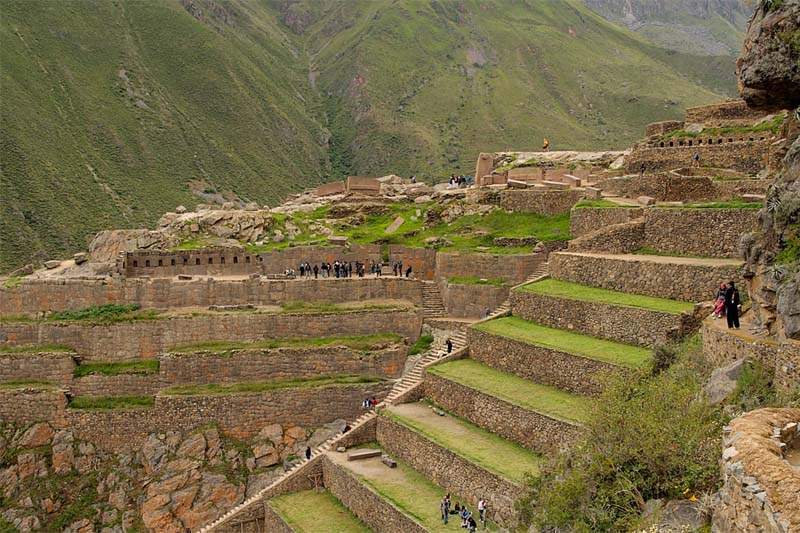
Archaeological Center of Ollantaytambo
1) Ollantaytambo: location, history and map
The town of Ollantaytambo in the Sacred Valley
-
Ollantaytambo is the only Inca town that is still inhabited. Its stone streets preserve the Inca architecture combined with temples and colonial squares.
-
It is presumed that it was the Inca Pachacutec (1438-1471) who ordered the construction of Ollantaytambo. Today, this picturesque town is a must for tourists visiting Machu Picchu.
-
Ollantaytambo is known as the ‘Living Inca City’. Its inhabitants maintain some of the traditions inherited by their Inca ancestors. Its main tourist attraction is the archaeological site (also called fortress) located next to the town.
-
Currently the town is conditioned to receive tourism. Around the Main Square of Ollantaytambo and in the town there are restaurants, hotels, bars, cafes and other services that invite the visitor.
Where is Ollantaytambo?
-
Ollantaytambo is at the opposite end of the town of Pisac (80 kilometers from the city of Cusco). It is reached by the Chinchero – Urubamba road or by train (km 68). The town is 2,700 meters above sea level (msnm) and houses some of the most amazing Inca buildings in Peru.
Did you know that the space of the archaeological complex of Ollantaytambo is co-founded with the town since many Inca channels are still in use. It is that the urban organization of the town maintains the same Inca planning. It could be said that Ollantaytambo is the last Inca town in Peru. To walk through its streets is to be transported to the Inca era.
What does Ollantaytambo mean?
-
The word Ollantaytambo derives from the Quechua word ‘Ulla-nta-wi’ which means “place to see down”. According to the Quechua culture, the name comes from ‘Ollanta’, the name of an Inca captain protagonist of the Quechua drama ‘Ollantay’.
-
The Spanish derivation of the Quechua word ‘Tambo’ means “City that provides accommodation, food or comfort for travelers”.
History of Ollantaytambo?
- Ollantaytambo was home to various ethnic groups and human groups, which, in the 15th century, were conquered and annexed to the Inca empire by Emperor Pachacutec.
- Previously there were simple clay constructions there. However, with the arrival of the Spanish, Pachacutec ordered the construction of various temples and stone enclosures of great importance such as the Temple of the Sun, the Enclosure of the 10 Hornacinas, the Baños de la Ñusta and more.
- For many years Ollantaytambo was a site of great importance both as a citadel and as a religious site. However, in the 16th century, the Spanish arrived in the city of Cusco, looting the temples and buildings of the city. The Inca rebels fled the city, facing the Spanish at Ollantaytambo in 1537.
- As a result of the clashes between the Inca army of Manco Inca and the Spanish led by Hernando Pizarro, many buildings were destroyed.
- The battles between the Incas and the Spanish there had terrible consequences for the current archaeological site, which was severely damaged in many of its structures. Finally, the Spanish besieged the site, but Manco Inca and his army fled into the jungle, settling in the city of Vilcabamba.
- Ollantaytambo became controlled by the Spanish. Their temples were looted. Some structures were destroyed to build temples and colonial mansions in their place. However, the town of Ollantaytambo maintained its Inca urban structure. Today it is the only town in Peru with these characteristics, which makes it a special place.
- Ollantaytambo is today one of the main tourist attractions of Cusco and Peru.
Archaeological complex of Ollantaytambo
-
The archaeological complex of Ollantaytambo was a military, religious and agricultural center. This fabulous architectural setting is interesting because of the size, originality and detail of its structures.
-
During the Spanish invasion in the 16th century it functioned as a fortress for the army of Manco Inca who faced the army of Hernando Pizarro.
-
As a result, many buildings were destroyed. However, today you can still see imposing buildings such as the Temple of the Sun, the 10 Hornacinas Enclosure, the Ñusta Baths and more.
Ollantaytambo travel map
2) What to see at the Ollantaytambo archaeological site?
Ollantaytambo has beautiful Inca lithic structures. Because it was the scene of hard battles between rebellious Incas and Spanish in 1537, many of its buildings are damaged or destroyed. Even so, the site still conserves the magic and history of many centuries ago.
-
The Royal House of the Sun
The Royal House of the Sun is made up of 17 very large superimposed terraces facing the main square of the town.
-
The strong Choqana
Choqana is a Quechua word meaning “where it is knocked down or thrown”. It is located 2 kilometers from Ollantaytambo. It served as an administrative center, checkpoint and strong.
-
The Square Mañay Raqay or ‘K’uychipunku’
Its name means in Quechua ‘Plaza of the petitions’. It is located on the right side of the Patakancha stream next to the entrance door of the archaeological site. Its walls have many openings that, it is believed, would be doors.
-
The temple of the Sun
This impressive monolith formed of 6 pieces is almost completely destroyed. However, it is still one of the most beautiful pieces of Ollantaytambo. The 6 huge rocks that form the western wall are coupled with incredible accuracy.
-
The Monumental Cover and the Enclosure of the 10 Niches
This construction is located at the end of the upper group of platforms. Its walls are constituted by two stone canvases polished with great precision. This site was damaged during the Spanish conquest. It is one of the most popular in ‘Ollanta’.
-
The Bath of the Ñusta
It is a beautiful fountain with 3 outlets of water sculpted inside. They are known as liturgical sources and could be found in the main cities of the Inca Empire.
-
The Platforms
In Ollantaytambo we find groups of parallel platforms. They have parameters inclined towards the hill with rungs that come embedded in their walls. They can be seen at a great distance.
3) How much does it cost to visit Ollantaytambo?
How to buy the tourist ticket to enter Ollantaytambo?
-
The entrance to Ollantaytambo is included in the Tourist Ticket of Cusco. This entry includes access to this and other tourist attractions such as: Pisac, Sacsayhuaman and Coricancha.
-
The Tourist Ticket of Cusco can be purchased in the authorized offices of Cusco.
-
Avenue El Sol 103, Cusco. (Tourist Galleries of. 101).
-
At the door of the same archaeological sites (Sacsayhuaman, Coricancha, Ollantaytambo).
-
-
You can choose to buy the Tourist Ticket ‘complete’ or ‘partial’. So, you can choose a certain group of places you want to visit. Keep in mind that buying the tickets for each site separately represents a greater expense.
-
Hours of service ‘Ollantaytambo archaeological site’: from 7 am to 6 pm (every day of the week).
-
- Note: Try to arrive early in the morning. This way you will avoid the tourist groups that start arriving at 11 a.m.
How to visit Ollantaytambo on a tour?
-
The Inca citadel of Ollantaytambo is one of the main tourist attractions of the Sacred Valley of the Incas.
-
To visit it with a tour, it is best to choose the Sacred Valley of the Incas Full Day tour. The tour includes a visit to the archaeological sites of Ollantaytambo, Pisac and Chinchero. Offers: pick up from the hotel, complete tourist transportation, professional tour guide, buffet lunch in Urubamba and return to the visitor’s hotel in Cusco.
-
The tour has a cost that varies from 50 to 80 dollars depending on the tourism agency you choose.
Budget to visit Ollantaytambo on your own
This is the budget if you are looking to visit the archaeological site of Ollantaytambo on your own:
|
Price for Peruvians
|
Price for foreigners
|
|
|---|---|---|
| Public bus ticket Cusco – Ollantaytambo | 12 PEN | 12 PEN |
| Tourist lunch in Ollantaytambo | 50 PEN | 50 PEN |
| Entrance to Ollantaytambo* | 40 PEN | 70 PEN |
| Professional tour guide in Ollantaytambo | 30 PEN | 30 PEN |
| Public bus ticket Ollantaytambo – Cusco | 12 PEN | 12 PEN |
| Total price | 144 PEN | 174 PEN |
* Cusco Tourist Ticket also includes entry to archaeological sites of Pisac, Chinchero and Moray.
4) More information about Ollantaytambo
Interesting facts
- In the Ollantaytambo compound, the rebel Incas faced the Spanish conquerors in 1537. ‘Ollanta’ served as a fortress and main headquarters of the rebel Inca army led by Manco Inca.
- On the slopes of Cerro Pinkuylluna (in front of the Citadel of Ollantaytambo) the Incas built stores of provisions also known as ‘colcas’.
- Currently, the starting point to the Inca Trail to Machu Picchu is located just 15 kilometers from the archaeological site of Ollantaytambo.
- At the end of June the ‘Ollantay Raymi’, a staging of the drama ‘Ollantay’, takes place in Ollantaytambo.
- According to an investigation, Ollantaytambo is geographically aligned with other important archaeological sites of the world such as Machu Picchu, Easter Island (Chile), the Pyramids of Giza (Egypt) and others.
Ollantaytambo Photo Gallery
Frequently Asked Questions about Ollantaytambo
-
1) Who built Ollantaytambo?
The chronicles indicate that Ollantaytambo was conquered by the emperor Pachacutec (1418 – 1471 AD) who ordered the construction of its current archaeological site.
-
2) What is the most famous construction in Ollantaytambo?
The Temple of the Sun is one of the most famous constructions in Ollantaytambo. It is a huge temple made up of six stone blocks weighing up to forty tons. Each of the rocks is carved and fits perfectly with its surroundings.
-
3) How much does the entrance to Ollantaytambo cost?
The Partial Cusco Tourist Ticket includes admission to the archaeological sites of Ollantaytambo, Pisac, Chinchero and Moray. This ticket costs 70 soles for foreigners and 40 soles for Peruvians.
-
4) When did the battle of Ollantaytambo take place?
The chronicles indicate that the battle of Ollantaytambo happened in January 1537 when the troops of Manco Inca resisted the assault of the Spaniards led by Hernando Pizarro. As a result, part of the constructions of the current archaeological site were damaged.
-
5) How much does a tour guide cost in Ollantaytambo?
If you visit on your own, the tour guide service can be hired at the gate of the Ollantaytambo archaeological site. The cost in shared service is approximately 15 soles per tourist.
-
6) How high is Ollantaytambo?
The town of Ollantaytambo is located at 2,792 meters above sea level.
-
7) How to get from Cusco to Ollantaytambo by public transport?
On Pavitos street in the historic center of Cusco you can board the public transport minivans that take you to Ollantaytambo (approximately 1 hour 45 minute trip). The cost is 10 soles per person.
-
8) How to get to the Ollantaytambo train station?
The train station is located in the same town of Ollantaytambo. Public transport minivans will take you to the station gate. From any part of the town you can also walk there.
-
9) When is Ollantay Raymi?
The Ollantay Raymi is a traditional festival that dates back to the same Inca era. Today more than three hundred actors and actresses participate to stage the Ollantay drama. This staging takes place at the archaeological site of Ollantaytambo every year at the end of June.
-
10) How much does a tour to Ollantaytambo cost?
The visit to Ollantaytambo is included in the Sacred Valley of the Incas tour whose cost is approximately 60 dollars per tourist (varies depending on the tourist agency you choose). This tour includes full transportation, tickets, tour guide and buffet lunch in Urubamba. It lasts approximately 10 hours (from 8 in the morning to 6 in the afternoon).
By Ticket Machu Picchu – Last updated, August 16, 2024
The post Travel guide: Ollantaytambo in the Sacred Valley first appeared on Ticket Machu Picchu.
]]>The post Intipunku, the sun gate in Ollantaytambo first appeared on Ticket Machu Picchu.
]]>- What is Intipunku?
- Location
- How to get to Intipunku?
- Route map
- The Sun Gate
- The arduous hike
- Andean landscapes
- Photos of Intipunku in Ollantaytambo
- Weather
- Some recommendations
- More information about the sun gate
- Difference between Intipunku of Machupicchu and Intipunku of Ollantaytambo
- Frequently asked questions about the Intipunku of Ollantaytambo
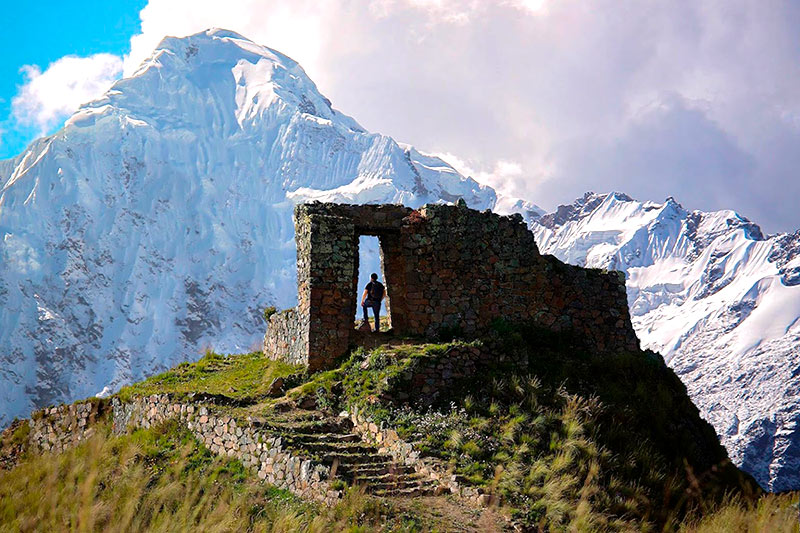
Intipunku – Ollantaytambo
Intipunku is a Quechua word that means ‘Gate of the Sun’. There are two famous ‘Intipunkus’: one in the upper part of the archaeological site of Machu Picchu and another at the top of Ollantaytambo (in the community of Cacchicata). To reach this last Inca construction, an ascent of approximately 2 hours must be made. There you can get incredible photos of the ‘Gate of the Sun’ and the Sacred Valley of the Incas.
What is Intipunku?
- The Intipunku is a construction made of stones as a center of worship to the Inca gods: the mountains, the sun, the stars, the moon and the earth.
- Its name comes from a Quechua word meaning ‘door of the sun’. During the mornings and especially during the summer solstices, the sun’s rays pass through this door, approximately 2.20 meters high and 1 meter wide.
- As in the famous Intipunku located in Machu Picchu, there the Incas performed religious ceremonies of great importance. Through this door you have a spectacular view of the snowy Verónica, also called Wakay Willka: sacred tears.
- Today the Intipunku of Ollantaytambo is a tourist attraction rarely visited by tourists because it is not included in a traditional tour. You can only go there on your own. Admission is free. Of course, you must take an arduous walk of 3 kilometers to get there.
Location
- Intipunku is on top of a mountain in the Sacred Valley of the Incas, 3,900 meters above sea level.
- It belongs to the district of Ollantaytambo (province of Urubamba), at the top of the community of Cachiccata.
- Geographically it lies above the banks of the Vilcanota River. At the top stand out the views of the snowy Veronica and Wakaywillca.
Intipunku route map
How to get to Intipunku?
To get to this tourist attraction from the city of Cusco, you must take the following route:
- From any part of the city of Cusco you must take a public transport minivan at the bus stop on Pavitos street (in the historic center of Cusco).
- The trip to Ollantaytambo is approximately 60 kilometers and lasts 1 hour 45 minutes (cost 10 soles). Once in this town, you must take a motorcycle taxi to the community of Cachiccata.
- The mototaxi ride to Cachiccata is 6 kilometers and takes almost 20 minutes. Once there, all you have to do is make an arduous walk uphill to the Intipunku.
- The walk is approximately 3 kilometers (2 hours depending on the pace of the tourist). Doing it is free. The return trip follows the same route as the outbound leg.
The Sun Gate
- The Intipunku has a structure similar to a door through which you have spectacular views of the mountains, especially the snow-capped Verónica, considered sacred by the Incas.
- Its name precisely means ‘Gate of the Sun’. In the morning the sun’s rays reach its stone structures. In addition to the door, there are small stone walls with adobe that support niches where sacred objects were placed in sacred rituals.
- To get to the Puerta del Sol, the Incas built roads that later joined the famous route of the Incas, the qhapac ñan.
The arduous hike
- To get to Puerta del Sol, you must take an arduous walk of approximately 3 kilometers uphill. The starting point is the community of Cachiccata.
- The route is called: “Trek Cachiccata – Intipunku”. The route lasts from 2 to 3 hours, depending on the physical condition of each tourist.
- The walking route has signs that indicate the correct path that leads to the Intipunku. There are deviations that also lead to the stone quarries of Qachiqata. A little further you can reach the Perolniyoc waterfalls.
- The walk has a moderate-high difficulty. The walk is recommended for tourists over 8 years of age who like this type of walk.
- The return leg follows the same path as the outbound journey.
Andean landscapes
- Once at the top of the Intipunku you can appreciate beautiful Andean landscapes such as: the snowy Verónica, the town of Ollantaytambo, the Vilcanota river, the terraces and cultivated fields of the Sacred Valley of the Incas and more.
- It is advisable to take a camera or even a drone with you. The entrance to the Intipunku is free. The best photos can be taken very early in the morning. For this reason, it is recommended to start the walk at 5 in the morning or even before.
Weather
- At the top of the Intipunku the climate is cold temperate with temperatures that vary from a maximum of 22ºC. (in the mornings and afternoons) to a minimum of 0ºC. (at night and early morning).
- The rains can happen every day of the year. However, the possibility of rain is more frequent from November to March (especially in February). The rest of the year the rains are less frequent.
Some recommendations
- During your visit to the Intipunku, take comfortable and resistant shoes with you . Also comfortable and sports clothing as well as a hat, sunscreen, mosquito repellent, poncho in case of rain, fruits, snacks, rehydrating drinks and everything in a suitable backpack.
- Take cash with you as the various tourist services do not accept credit or debit cards. Transportation services and restaurants only accept money in Peruvian soles, not dollars or euros.
More information about the sun gate
- Entrance to Intipuku is free.
- There are no commercial tours to this tourist destination. However, you can hire a professional tour guide to accompany you during the trek. Prices vary depending on the tourism agency you choose or the rate agreed with the tour guide.
- The Intipunku of Machu Picchu is one of the most amazing constructions of the ‘Inca citadel’. To reach the top, you must walk 1 kilometer to the top of this building. The Intipunku was the access door to the Inca citadel at the time of the Incas. Today you can also get there through the 4-day Inca Trail, just like the Incas did.
Difference between Intipunku of Machupicchu and Intipunku of Ollantaytambo
| Details | Intipunku of Machu Picchu | Intipunku of Ollantaytambo |
| Location | Machu Picchu archaeological site | Cachiccata community in Ollantaytambo |
| Height | 2,745 masl | 3,900 masl |
| Hike | 1 hour uphill | 3 hours uphill |
| Climate | Tropical temperate | Cold temperate |
| Landscape | High jungle | High andean |
| Price | With the Inca Trail to Machu Picchu tour | Free |
| buildings | A set of carved stone buildings overlooking Machu Picchu | A stone doorway carved by the Incas overlooking the Sacred Valley |
Frequently asked questions about the Intipunku of Ollantaytambo
-
What does intipunku mean?
Intipunku is a Quechua word that means ‘door of the sun’.
-
Where is the Intipunku?
The Intipunku is located on top of a mountain that belongs to the Cachiccata community in Ollantaytambo (61 kilometers from the city of Cusco).
-
Is the walk to the Intipunku of Ollantaytambo difficult?
Yes. The walk is uphill for a steep section. It takes between 2 to 3 hours depending on the physical resistance of the person.
-
How much does it cost to visit the Intipunku of Ollantaytambo?
There are no entrance tickets to the Intipunku of Ollantaytambo. Admission is free for all tourists.
-
What is the difference between the Intipunku of Ollantaytambo and Machu Picchu?
The Intipunku of Ollantaytambo has incredible views of the Sacred Valley of the Incas while the Intipunku of Machu Picchu offers panoramic views of the beautiful Inca citadel.
-
How high is the Intipunku of Ollantaytambo?
The Intipunku is at 3,900 meters above sea level.
-
How is the weather in the Intipunku?
The climate in the Intipunku is cold temperate with strong winds. The temperature varies from 0ºC. (at night) up to 16ºC. (on day). The rains can occur at any time, especially from January to March.
-
What car to take to visit the Intipunku?
The first step is to travel from Cusco to Ollantaytambo. To do this, you must take the minivans that leave from Pavitos street. Then take a taxi or motorcycle taxi to the community of Cachiccata. There the walk begins.
-
Is it dangerous to visit the Intipunku?
No. The route is hard, difficult but not dangerous. It is recommended to follow the indicated paths with the appropriate footwear and a travel backpack with snacks, drinks and whatever you consider necessary.
-
How to see the sunrise from the Intipunku of Ollantaytambo?
Many tourists seek to see the sunrise from the Intipunku, an incredible natural spectacle. For this, it is necessary to leave Cusco at around 2 am and start the trek to Intipunku at 4 am. You will be able to see the sunrise at approximately 6 am.
Advice from people who have been there
 By: Brayan M.
By: Brayan M.“Sun Gate!“
“We went by miniban to Cachicata and then we walked along an ascending path towards the Puerta del Sol, we left very early to see the sunrise. Very good trek!“
By Ticket Machu Picchu – Last updated, August 15, 2024
The post Intipunku, the sun gate in Ollantaytambo first appeared on Ticket Machu Picchu.
]]>The post Ollantaytambo: Inca altar found on the Urubamba river first appeared on Ticket Machu Picchu.
]]>It was found a “stone altar dating back to the time of the Incas”, it was believed that this piece had been destroyed in 2014, when the construction of the road of avoidance was carried out. The find was certified by the historian from Cusco Victor Angles. Ollantaytambo has some of the most impressive Inca ruins that can be seen in the Sacred Valley of the Incas; Comparable only to what you can see in Pisac or in the same Inca city of Machu Picchu. Many people take time in this small town to visit the Inca ruins of Ollantaytambo; Also, it is a mandatory stop for people who go to Machu Picchu, because it is in this place where you will have to board the train to Aguas Calientes.
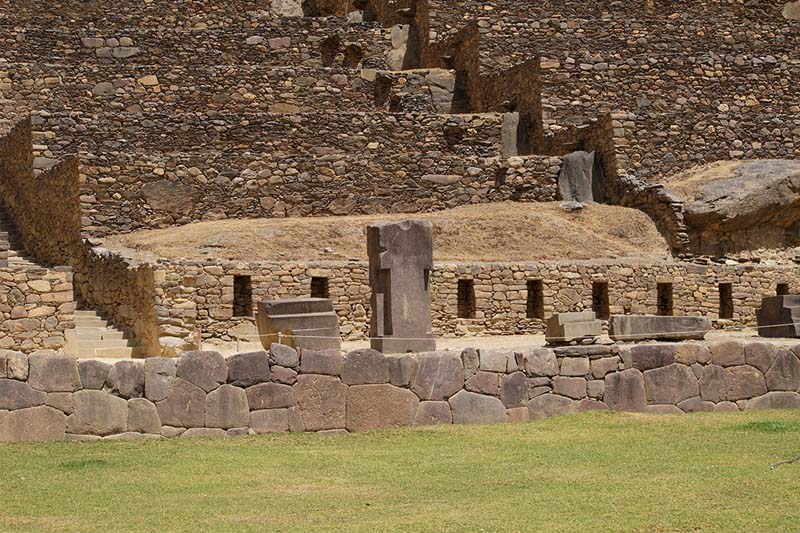
The Archaeological Park of Ollantaytambo would be the appropriate place to receive the Inca altar found
Inca Altar on the Urubamba River (Vilcanota) in Ollantaytambo
A group of workers working on the conservation of the Urubamba River in the province of the same name, in Cusco, found a stone altar that was believed to have been lost since 2014, when it was lost sight of during the construction of one of the access roads to the city. The altar dates back to the Incas (XVth century), it could be a further proof of the Inca’s devotion to water, this liquid element was sacred to the Inca civilization.
Where was the altar found?
An altar of Inca invoice that was believed destroyed during the works of the road of avoidance in 2014, was found by conservative workers of the deconcentrated direction of Culture of Cusco, during cleaning works of the Urubamba river at the height of km 88 of the way In the district of Ollantaytambo, province of Urubamba.
The town of Ollantaytambo is located in the Sacred Valley of the Incas at 2 hours and a half from Cusco City, You can arrive in a collective (minivans) from Pavitos Street. The Sacred Valley of the Incas is one of the places you will enjoy on your trip to Ollantaytambo Machu Picchu; You can see dazzling landscape, the Urubamba River, streams, snowy and small towns full of history and tradition. If you want to know how to get from Ollantaytambo to Machu Picchu, enter here.
Description of the Inca altar
The Inca altar is finely carved, although only 35% of it can be seen on the river waters, its dimensions are 2.5 meters long, 1 wide and weighs about 20 tons; The cleaning work on the banks of the Urubamba River will allow the Inca altar to be seen in all its integrity. The enormous lytic piece can not be extracted because of its weight and that was covered with weeds and debris. Óscar Montufar, coordinator of the Archaeological Park of Ollantaytambo indicated that “it is not only a question of recovering the altar, but of doing so in all its integrity”; In addition they will have to relocate it. This piece is a further indication of the water cult practiced by the Incas.
The altar of the Urubamba River was registered and described by the archaeologist and historian from Cusco, Victor Hugo Vargas, in the 1980s. The Inca altar is being subjected to cleaning and other routine treatments to stabilize and consolidate it with the support of personnel Specialized in the chemical physical laboratory of the Directorate of Culture Cusco.
Where can you see the altar?
It is not yet decided where the “Inca altar” will be placed, there are two possible places; One of them could be placed in the Plaza de Armas of Ollantaytambo; However, another alternative is to put it inside the Archaeological Park of Ollantaytambo. In our opinion, this is where an “Inca altar” should be.
Advice from people who have been there
 By: Lynne W
By: Lynne W“A must see. Colossal place. Highly recommend!“
“You'll have to prepare yourself for a good climb, but it's worth it; Ollantaytambo is one of the Inca ruins that is at the height of Machu Picchu, it is extraordinary, and it is fascinating to learn how and why it was built. Nearby you can see the quarry from where they moved the stones to build Ollantaytambo.“
By Ticket Machu Picchu – Last Update, 05-18-2017
The post Ollantaytambo: Inca altar found on the Urubamba river first appeared on Ticket Machu Picchu.
]]>The post Ollantaytambo: one of the most impressive places in South America first appeared on Ticket Machu Picchu.
]]>In fact, Ollantaytambo is not only one of the most impressive places in South America, but the land. This ancient Inca city is enveloped in a mystery that experts can not explain; And it is that like Machu Picchu and other important places and cities of the most important ancient cultures of the world, its megalithic constructions have an inexplicable perfection, and irremediably makes doubt to all the people who see them, that the stones with which they were Built have been carved with chisels and percussion tools; But on the contrary, it seems that they would have been, in some strange way, molded to perfection and stacked in the walls without need of any kind of glue; As if they had taken their shape in a 3D printer.
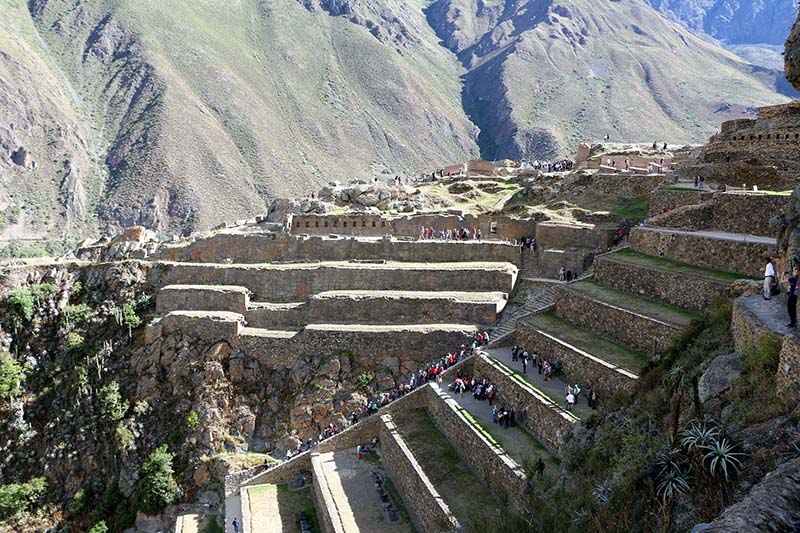
Archaeological complex of Ollantaytambo
Where is Ollantaytambo?
This complex is located 3,000 meters high in the middle of the Sacred Valley of the Incas and is one of the most important Inca sites in Peru; However, many scholars agree that it may be prior to the Inca’s own empire. To get to Ollantaytambo you will have to arrive first to the city of Cusco.
What makes Ollantaytambo such a special place?
Well, talking about Ollantaytambo is talking about one of the most impressive megalithic sites in South America. Granite blocks of up to 80 tons perfectly carved form the walls of their constructions, but many of these stones were extracted directly from the mountainside, on the other side of the valley. But its incredible stone constructions are not the only thing amazing about this place, because if you did not know, Ollantaytambo is aligned with other important ancient constructions around the world, the pyramids Giza, Paratoari, Nazca lines or the statues of the Easter islands are just a few of them.
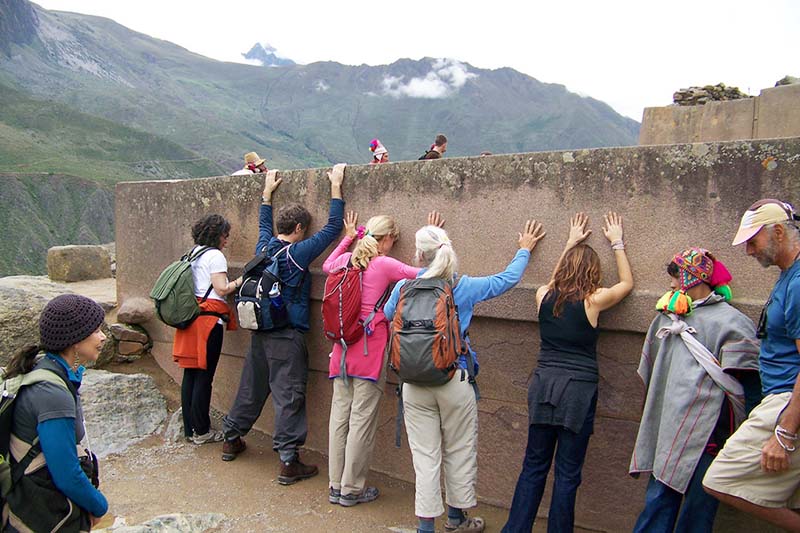
Tourists receiving the “energy” of one of the gigantic blocks of stone found in Ollantaytambo
How was Ollantaytambo built?
The incredible structures of Ollantaytambo suggest to many experts the possibility that the people who built it, knew ancient technology lost at some point in time, perhaps even before the Inca civilization. They knew something that allowed them to shape the stones with incredible precision, perhaps the same old technology that shaped the “stone spheres of Costa Rica” or the “moais, statues of the Easter Islands in Chile.” One of the great mysteries of Ollantaytambo is why the temple of the sun was never completed.
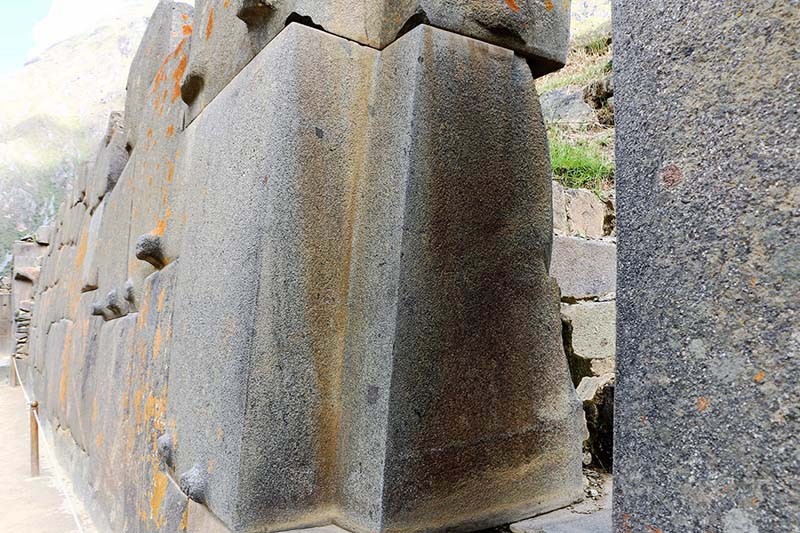
Incredible precision with which stones were carved in Ollantaytambo
The Temple of the Sun in Ollantaytambo
The temple of the sun is one of the most amazing constructions that you can see in Ollantaytambo, it consists of 6 monoliths each made of stones of tens of tons, so the builders had no problem with the weight, but then, why Never got to finish?, or so it seems.
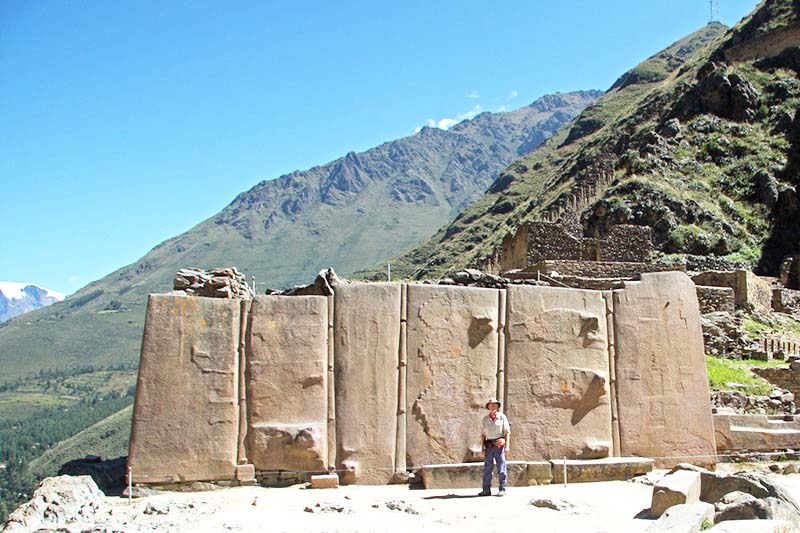
Temple of the Sun and its huge monoliths
The precision with which they built Ollantaytambo is extraordinary
But it is not only his alignment with other incredible constructions on earth, but the incredible precision with which his stones were “carved.” Some of the corners fit so perfectly that they have puzzled archaeologists all over the world.
Many scholars agree that a work of such magnitude can only be made with quartz, carbon, hardened or cobalt glass; However, the Incas did not know these materials, or so it seems, because until today no tools of this type have been found in Ollantaytambo.
The complexity of Ollantaytambo coincides with places like Tiahuanaco, Puma Punku or the Great Pyramid of Giza (2,570 BC), but these places are separated not only by thousands of kilometers, but also for thousands of years in the history of time.
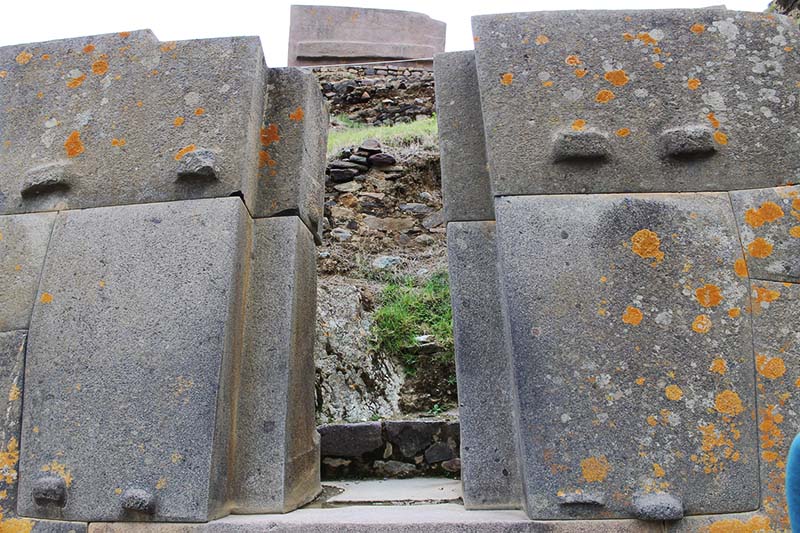
Perfectly carved stone door
Ollantaytambo today
The only thing that can be said about Ollantaytambo at this moment is that it is an ancient wonder, and that you can not miss it on your trip to Machu Picchu, as it has buildings as impressive as the wonder of the world, but it is not famous And there are not many people running at the same time. Many questions have been asked about this place. Visit it before it becomes better known and that like the tickets Machu Picchu, you have to reserve your income well in advance.
What ticket will you need to visit the ancient city of Ollantaytambo?
You will need to know how to buy the Cusco tourist ticket to enter the archaeological complex of Ollantaytambo, and as we said before, visit it before more people know what they can see in this place.
Advice from people who have been there
 By: Lia Alessandra F
By: Lia Alessandra F“Magical“
“Worth every step you have to climb to see what is up there. The height of this place is one of the things that worries people, but do not be afraid to chew coca and climb slowly, but it arrives, it is something that like Machu Picchu, you have to see.“
By Ticket Machu Picchu – Last Update, 05-18-2017
The post Ollantaytambo: one of the most impressive places in South America first appeared on Ticket Machu Picchu.
]]>The post The alignment of Ollantaytambo with other ancient sites of the planet first appeared on Ticket Machu Picchu.
]]>Many know that it is a charming town and an ancient Inca city that can be seen on the way to Machu Picchu, but only those who give themselves the time to see their details, end up realizing that the ancient Inca city of Ollantaytambo is amazing. He has incredible structures that relate it to “old advanced technology”, but even more, he will be amazed to know – if he did not know – about the alignment of Ollantaytambo with other ancient sites of the planet.
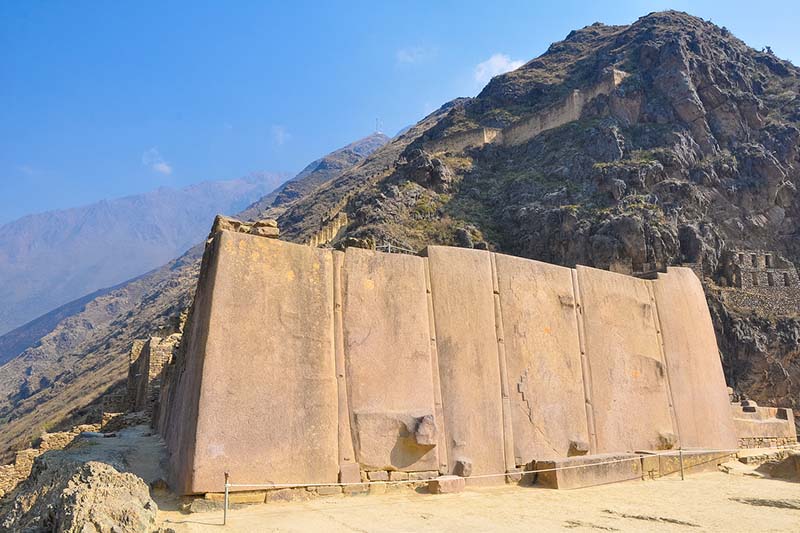
Ruins of the ancient Temple of the Sun, in Ollantaytambo
Ollantaytambo is aligned with other ancient sites in the world
Easter Island in Chile, the Nazca lines in Peru, Ollantaytambo in Peru, the pyramids of Pantiacolla (the enigmatic pyramids of Paratoari in the Amazon) in Peru, the ancient paintings of Tassili n’Ajjer in the south of Algeria, in the Sahara Desert and the Pyramids of Giza in Egypt, are lined up in a large circle. I knew it? This alignment within the geodesic lines of the planet is incredibly amazing and gives Ollantaytambo a much greater meaning than we were giving it.
They are no longer just theories. Thanks to the systems of global positioning, it is known of many old structures in the whole world constructed in very specific places, thousands of years ago. One of the best examples of the position of ancient structures on the geodesic lines of the planet is the Giza pyramid in Egypt. If you did not know, the position of the pyramid of Giza is very curious, because it is the structure more precisely aligned with the magnetic north, with only 3/70 of a degree (1°) of error.
Another amazing feature of the Pyramid of Giza is that its weight is estimated at 5,955,000 tons; This number multiplied by 10 is a reasonable estimate of the total mass of the land. Then you may notice that these ancient constructions were constructed deliberately aligned in points with incredible accuracy.
Other sites aligned to this circle
In addition to the pyramid of Giza; Siwa, Paratoari, Tassili n’Ajjer, Ollantaytambo, Machu Picchu, Easter Island, Nazca, Pyay, Khajuraho, Aneityum Island, Mohenjo Daro, Preah Vihear, Persepolis, Ur, Sukhothai and Petra, have exact locations and are shown in direction Clockwise from the circle of the pyramid of Giza, with exactly scaled distances.
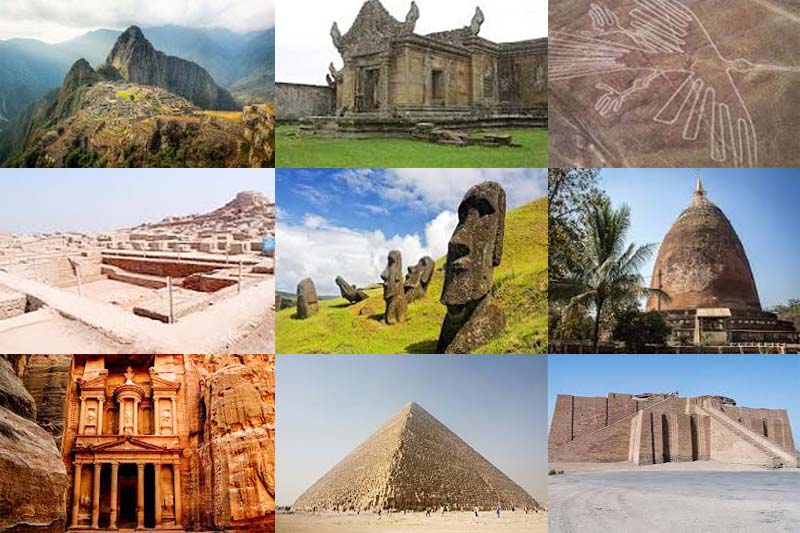
Ancient constructions around the world that have a common alignment
The following list shows the distance of each site respect from the large circle
The circle crosses the equator and polar regions. The average distance from the axis point to the large circle is 6,218 miles.
| * | Giza | 0 miles | |
| * | Siwa | 10 miles | |
| * | Tassili n’Ajjer | 0 miles | |
| * | Paratoari | 0 miles | |
| * | Ollantaytambo | 0 miles | |
| * | Machu Picchu | 15 miles | |
| * | Nazca | 0 miles | |
| * | Isla de Pascua | 0 miles | |
| * | Isla Aneityum | 8 miles | |
| * | Preah Vihear | 25 miles | |
| * | Sukhothai | 5 miles | |
| * | Pyay | 5 miles | |
| * | Khajuraho | 12 miles | |
| * | Mohenjo Daro | 20 miles | |
| * | Persépolis | 5 miles | |
| * | Ur | 40 miles | |
| * | Petra | 6 miles |
How can you verify this by yourself?
This alignment is easily observable on a globe of the earth with a horizon ring; It is enough to place the ring in two of the places with distance 0 (zero) and the others will line up by themselves.
What secret hides this?
If you can do this you will realize that this circle connects the old structures we mentioned at the beginning of this post; But to the surprise of many, it also encompasses the major constructions of ancient cultures and civilizations across the globe. We suppose that, like us, he kept his mouth open and wanted to know more about this profound enigma; Unless you think this is just another strange coincidence.
Do you want to visit Machu Picchu, Ollantaytambo and other amazing places in Cusco? Contact us at [email protected].
Advice from people who have been there
 By: Miriam Edith C
By: Miriam Edith C“Magical“
“Ollantaytambo is the starting point to get to Aguas Calientes and consequently to Machu Picchu, but this village gives off a special magic, I recommend not to rush and stay at least 2 days in it, to enjoy the town and the amazing Inca ruins.“
By Ticket Machu Picchu – Last Update, 05-17-2017
The post The alignment of Ollantaytambo with other ancient sites of the planet first appeared on Ticket Machu Picchu.
]]>The post The best restaurants in Ollantaytambo first appeared on Ticket Machu Picchu.
]]>If you are already on your way to Machu Picchu, do not miss the opportunity to taste Peruvian food, as you should know, Peru is considered the best gastronomic destination in the world.
The small town of Ollantaytambo offers a variety of restaurants to satisfy your hunger before taking the train trip to Machu Picchu, or as a starting point for people who will travel the Inca Trail. Enjoy good food before embarking on your trip to Machu Picchu.
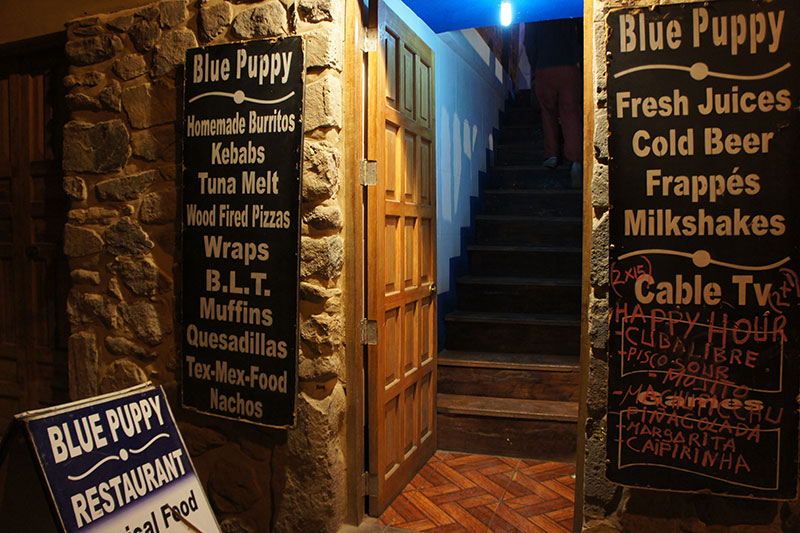
Restaurant in Ollantaytambo
Restaurants in Ollantaytambo
-
Mayupata (Peruvian fusion cuisine)
It is one of the most luxurious restaurants in the city of Ollantaytambo, offering a wide selection of international dishes with Peruvian touch. Here you can enjoy delicious trout dishes with a spicy pisco sour cocktail. We especially recommend the Mayupata trout; In this restaurant you will find edible art.
- Address: Jr. Convention (In front of the Temple of Santiago Apostle)
- The average price is $ 10 per plate
- Phone: 084 204 009
- Hours: from 10 am to 9 pm
Note: The pizzas are quite large and ideal for at least 2 travelers with a lot of appetite.
-
Blue Puppy Restaurant and Lounge (Peruvian Mexican and Italian fusion cuisine)
El Perrito Azul is a restaurant that offers appetizers, soups, quesadillas, pastas, pizzas and salads, but also has a selection of vegetarian dishes (ideal for large groups). This two-level restaurant offers great views of the city landscape and the mountain behind it. It has chairs and lounge sofas, making to Blue Puppy one of the most comfortable options when compared to other restaurants in the area.
- Address: Central Square, Calle del Horno
- The average price is $ 10 per plate
- Phone: 084 630 464
- Hours: 7:30 am – 11:30 pm
Note: Blue Puppy is also a great place to drink a cocktail, a fresh fruit juice or a milkshake.
-
Puka Rumi (Mexican fusion cuisine)
In this restaurant they boast of serving good Mexican food; However, in its menu you will find a mix of international flavors, as burritos, to a variety of dishes made from chicken and meat. It is a good place to enjoy a cold beer on the small terrace, outdoors.
- Address: Street Ventiderio
- The average price per plate is $ 7
- Phone: 084 204 151
- Hours: Every day 7:30 a.m. to 10 p.m.
Note: Try the burritos.
-
Coffee Mayu (Coffee)
This small cafe is part of the hostel and is located right next to the train tracks. Here you can enjoy pasta, salads or hot sandwiches. It is a great place for breakfast and bakery.
- Address: Ollantaytambo train station
- The average price per plate is $ 8
- Telephone: 084 204 014
- Hours: Every day from 7 am to 7 pm
Note: You will need to pay in cash as this place does not accept credit cards.
-
Pachamama (pizzeria)
You can find this pizzeria right in the Plaza de Armas; Offers the opportunity to relax with a hearty plate and a glass of wine. You can find varied alternatives, meat dishes, pastas, pizzas and salads. This place is perfect for breakfast, lunch or dinner.
- Address: Central Square of Ollantaytambo
- The average price per plate is $ 8
- Phone: 084 204 168
- Hours: Every day from 8 am to 10 pm
Note: It has outdoor tables that allow you to watch some of the locals in typical costumes spend quietly.
-
Hearts Coffee (Coffee)
This coffee was created by the British Sonia Newhouse; She also created an NGO to help women and children in this part of the Peruvian sierra. All the benefits generated by coffee, are destined directly to the NGO; Here you will not only enjoy a good coffee, but you will be contributing to the cause of help. You can also find delicious breakfast dishes.
- Address: Avenue Ventiderio
- The average price is $ 5
- Phone: 084 436 726
- Hours: Every day from 7 am to 10 pm
Note: You do not accept credit cards.
By Ticket Machu Picchu – Last Update, 05-17-2017
The post The best restaurants in Ollantaytambo first appeared on Ticket Machu Picchu.
]]>The post What is Ollantaytambo? first appeared on Ticket Machu Picchu.
]]>Learn all about the archaeological site of Ollantaytambo in Cusco, Peru.
- What does Ollantaytambo mean?
- When was Ollantaytambo founded?
- What is the historical importance of Ollantaytambo?
- How is the archaeological site of Ollantaytambo?
- What is the town of Ollantaytambo like?
- What places to visit in Ollantaytambo?
- The Temple of the Sun in Ollantaytambo
- The platforms of Ollantaytambo
- What else to see in Ollantaytambo?
- How to buy the ticket to visit Ollantaytambo?
- Interesting facts about the archaeological site of Ollantaytambo
- Questions and answers about Ollantaytambo
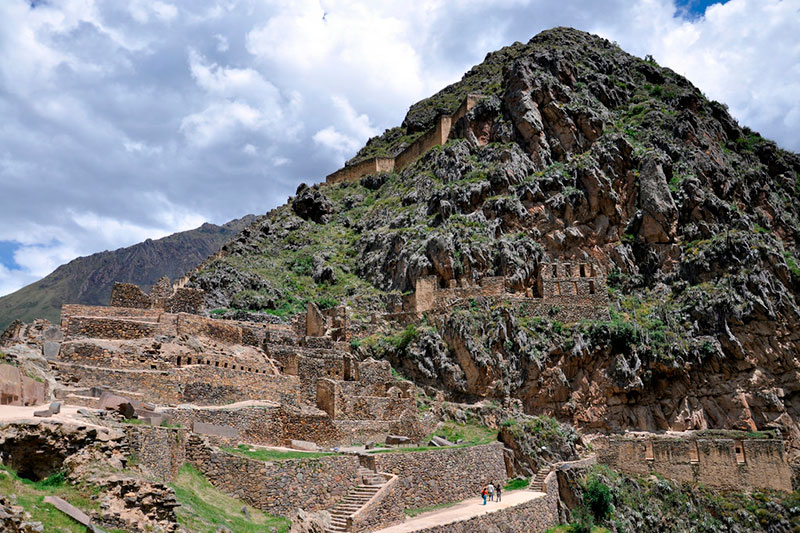
Inca Complex of Ollantaytambo
What does Ollantaytambo mean?
- According to various studies, Ollantaytambo is a word of Aymara origin (language of the Peruvian high plateau) that would mean “place of observation from below”.
- In Ollantaytambo, culture and history are deeply combined, producing the admiration of the people who visit it.
- If you decide to tour the city of Ollantaytambo on your trip to Machu Picchu, you will enjoy not only green and beautiful landscapes but also the daily life of the inhabitants of this ancient human settlement.
- According to oral tradition, Ollantaytambo owes its name to the Inca drama ‘Ollantay’, whose protagonist was the Inca general ‘Ollanta’.
When was Ollantaytambo founded?
- In the middle of the 15th century, Emperor Pachacutec destroyed the town that settled there to found Ollantaytambo and incorporate it into the Inca Empire.
- Pachacutec ordered the construction of the main buildings of the current archaeological site of Ollantaytambo.
- Pachacutec is known as the Inca builder. Under his rule, the Incas also built the Inca Citadel of Machu Picchu.
- Until today, the town of Ollantaytambo conserves its urban organization as well as many Inca walls.
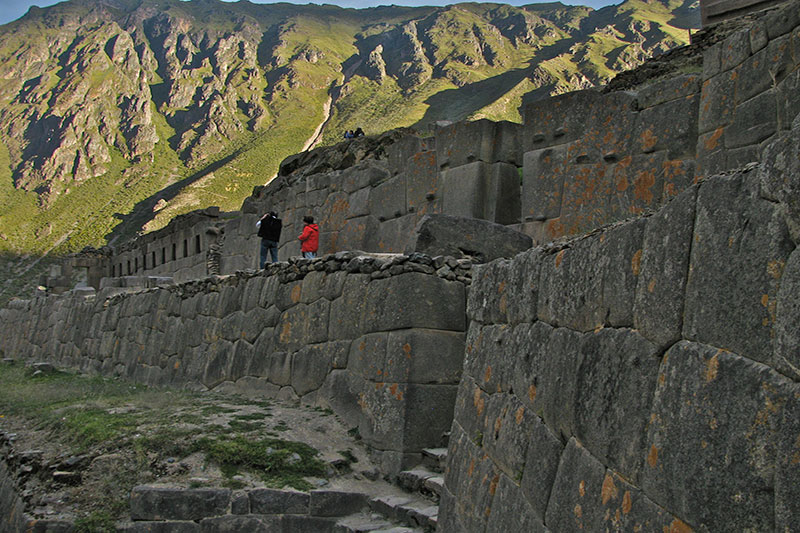
Inca walls in Ollantaytambo
What is the historical importance of Ollantaytambo?
- Ollantaytambo was an important religious, agricultural and also military center. Due to its strategic location during the conquest it served as a defense post against the Spanish.
- In 1537 the Spanish conquistadors faced off with the last Incas who resisted the European invasion in Ollantaytambo.
- The resistance of Manco Inca could not stop the Spanish attack so they had to flee to the city of Vilcabamba, in the jungle of Cusco.
- The city was in the hands of the invaders and being an ‘encomienda’ at the hands of Hernando Pizarro.
The encomiendas were territories placed at the disposal of the Spanish colonizers. Due to this, Ollantaytambo combines Inca, colonial and contemporary buildings.
How is the archaeological site of Ollantaytambo?
- Ollantaytambo is located at the top of the mountains from where the town is watched as well as all the Sacred Valley of the Incas.
- Ollantaytambo has some of the best construction work done by the Incas as the Sun Temple.
- It was believed for a long time that the city was a kind of defense fortress. However, the quality of the work suggests that it also served as a resting place for the Inca and his family.
What is the town of Ollantaytambo like?
- The town of Ollantaytambo retains its Inca urban layout very well organized with a polygonal design. The square is in the center of the same city.
- At present, the space occupied by the town of Ollantaytambo is a fraction that it had in antiquity.
- The south side of the town of Ollantaytambo shows a higher quality construction. The north side, on the other hand, has lower quality buildings.
- Currently, the town has various tourist services such as hotels, restaurants, cafes and many places to visit.
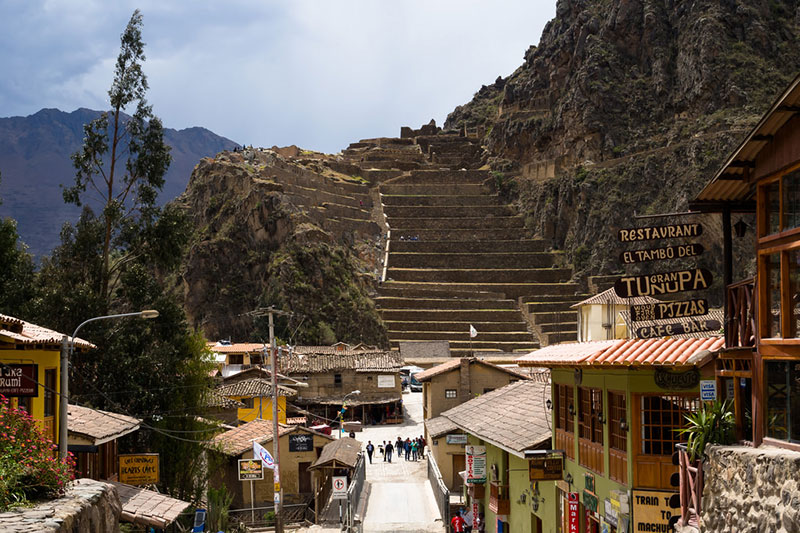
Entrance to Ollantaytambo
What places to visit in Ollantaytambo?
- The archaeological site of Ollantaytambo has various buildings such as the Ñusta Bath, the Real Casa del Sol, the Monumental Home and many others.
- However, the most popular and imposing buildings in Ollantaytambo are the Temple of the Sun and the beautiful andenería system.
- At the top of the mountains that surround Ollantaytambo you can visit some constructions called ‘Colcas’. These structures served as warehouses for basic products such as corn or potatoes.
The Temple of the Sun in Ollantaytambo
- To the west of the Ollantaytambo you will find a building known as ‘Aracama’. In this place is the Temple of the Sun.
- The Temple of the Sun is a unique building in the Sacred Valley.
- It is built on top of a pyramid of terraces that lead to the Main Square.
- In the Temple of the Sun 6 monoliths survive that form one of the most impressive buildings of the Sacred Valley of the Incas.
- The Temple of the Sun must have been a ceremonial place. It is also believed that they stopped construction during the Spanish invasion.
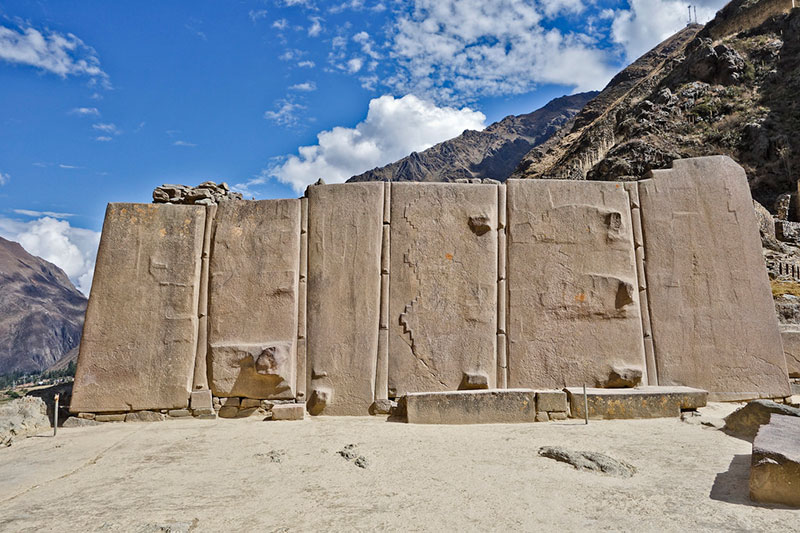
The Temple of the Sun in Ollantaytambo
The platforms of Ollantaytambo
- The agricultural terraces of Ollantaytambo are one of the best examples of agricultural engineering developed by the Incas.
- They are 700 meters long, 58 meters wide and 15 meters deep. Everything is built in relation to the position of the sun and the natural environment.
- The platforms create particular microclimates that allow the cultivation of different products in higher or lower areas.
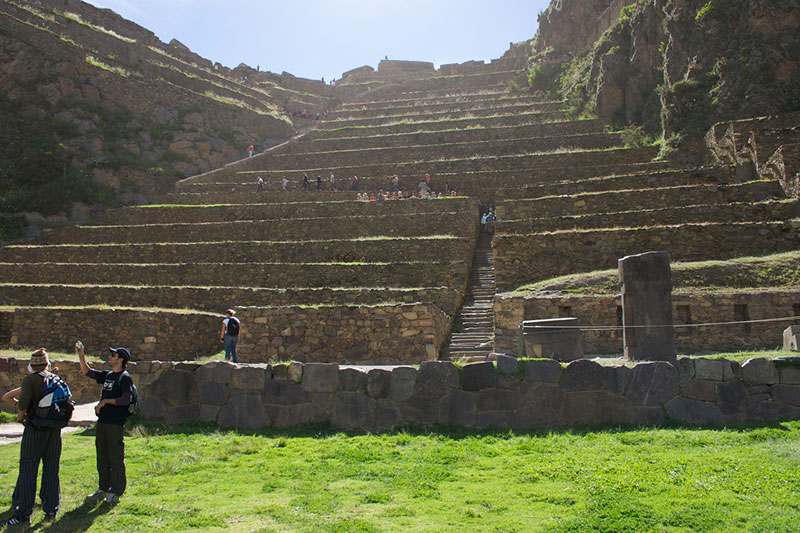
Andenería in Ollantaytambo
What else to see in Ollantaytambo?
- In Ollantaytambo you can also visit the abandoned quarries from which the construction material of the city was extracted.
- From Ollantaytambo you can take walks to Pumamarka or visit the Yanacocha lagoon.
- From Ollantaytambo the trains leave in the direction of Machu Picchu. Visit the archaeological site or the Inca people is a good option before knowing the Wonder of the World.
How to buy the ticket to visit Ollantaytambo?
- To enter Ollantaytambo you need to buy the Cusco Tourist Ticket circuit 3. This ticket, in addition to Ollantaytambo, includes admission to the archaeological sites of Moray, Chinchero and Pisac.
- The ticket can be purchased at the entrance gate of Ollantaytambo or at the authorized offices in the city of Cusco: Avenue El Sol 103 or Calle Garcilaso s/n.
- The cost of the Cusco Tourist Ticket is 70 soles. The tourist has up to two days to visit all the places included in this ticket.
- The purchase of this ticket is only in person. At the moment it cannot be purchased online.
Interesting facts about the archaeological site of Ollantaytambo
- The town of Ollantaytambo is full of Inca constructions. In addition to its archaeological site in the surrounding mountains, you can distinguish colcas, enclosures and even an Intipunku (gate of the sun). To get to this last construction, you must walk approximately 2 hours.
- Ollantaytambo also celebrates an Inca festival similar to the famous Inti Raymi of Cusco. This is ‘Ollantay Raymi’, a staging based on the historic drama of Ollantay. The main stage of this festivity is the archaeological site of Ollantaytambo. That day, at the end of June, the staging takes place with hundreds of visitors.
- The archaeological site of Ollantaytambo can be visited with the ‘Sacred Valley of the Incas 1 day Tour’. This service offers complete transportation, entrance to all sites, lunch in Urubamba and professional tour guide service. The places to visit are the archaeological sites of Pisac, Chinchero and, of course, Ollantaytambo. The cost of the tour varies from 30 to 70 dollars per tourist. It depends on the tourism agency you choose.
Questions and answers about Ollantaytambo
-
1) Who ordered the construction of Ollantaytambo?
Emperor Pachacutec was the one who ordered the embellishment and construction of the current archaeological site of Ollantaytambo in the mid-15th century. Shortly before he had conquered this town and extended the limits of the Inca empire.
-
2) What does Ollantaytambo mean?
The word Ollantaytambo, translated from Quechua Ullantaytampu, means ‘Ollanta inn’. This name refers to the character of ‘Ollanta’ in the drama of ‘Ollantay’ who was an Inca general who ruled in this Andean town.
-
3) What to see in Ollantaytambo?
Ollantaytambo is famous for its Inca archaeological site. There you can see amazing stone constructions such as: the Temple of the Sun, the Royal House of the Sun, the Monumental Portal, the Enclosure of the 10 niches, the Ñusta baths and more.
-
4) What was the function of Ollantaytambo?
Ollantaytambo was an Inca citadel that, like many, had temples, platforms (agricultural production) and enclosures for people of high society as well as the common people. However, in the 16th century it also served as a fortress due to the battle between the Spanish and the Incas.
-
5) Who fought in Ollantaytambo?
The chronicles indicate that in January 1537 in Ollantaytambo the army of Manco Inca (leader of the Vilcabamba rebellion) clashed against the Spanish army led by Hernando Pizarro. The Incas resisted there until they were defeated so they fled to the jungle of Cusco (Vilcabamba).
-
6) Is it dangerous to visit Ollantaytambo?
Ollantaytambo offers a safe visit. There are no risky sections for the visitor’s health. However, it is recommended not to approach the margins of the paths.
-
7) How high up is Ollantaytambo?
Ollantaytambo is situated at 2,792 meters above sea level.
-
8) What landscapes can I see in Ollantaytambo?
In Ollantaytambo you can appreciate natural landscapes of great beauty such as the Urubamba River, a set of farmlands as well as the Verónica, Chicón and Sahuasiray snow-capped mountains.
-
9) How to go from Cusco to Ollantaytambo?
The trip from Cusco to Ollantaytambo can be done by public transport. To do this, you must take the public transport minivans that leave from Pavitos street (in the historic center of Cusco). The journey takes 1 hour 40 minutes. It costs 10 soles on average.
-
10) How much does a tour to Ollantaytambo cost?
The visit to Ollantaytambo is included in the tour to the Sacred Valley of the Incas for 1 day. This service also includes admission to the Inca sites of Chinchero and Pisac. The tour includes everything: transportation, guide, tickets and even lunch. The cost varies from 30 to 70 dollars, depending on the tourism agency you choose.
By Ticket Machu Picchu – Last updated, August 15, 2024
The post What is Ollantaytambo? first appeared on Ticket Machu Picchu.
]]>The post What to do in Ollantaytambo? first appeared on Ticket Machu Picchu.
]]>- Basic information about Ollantaytambo
- Ruins of Ollantaytambo
- Catcco Museum
- Plaza de Armas and Church of Ollantaytambo
- Town of Ollantaytambo
- Archaeological site of Pinkuylluna
- Perolniyoc Waterfalls
- The Yanacocha lagoon
- Experiential tourism in Ollantaytambo
- Inca Trail
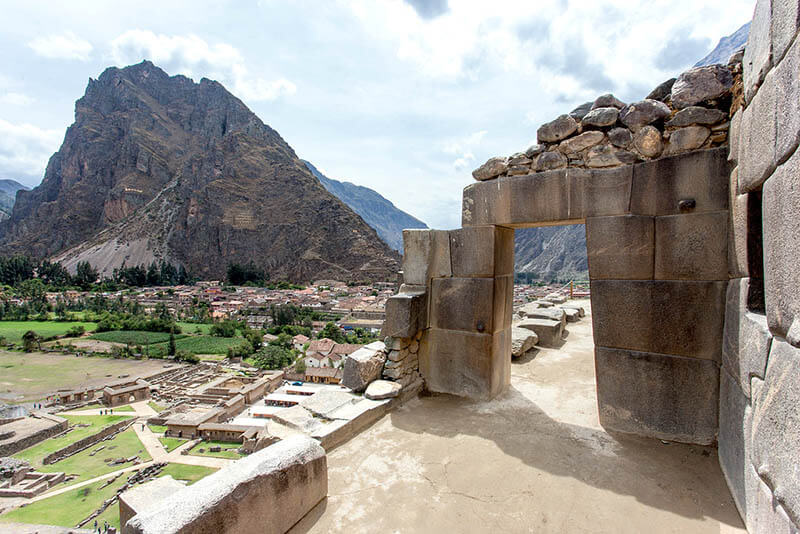
View of the Town of Ollantaytambo
Basic information about Ollantaytambo
First we will know some details about this peculiar town:
- Height in meters and feet: 2792 meters above sea level (9160 feet).
- Location: It is located 72 kilometers northeast of the city of Cusco in the Sacred Valley of the Incas.
- Climate: The climate is dry and rainy depending on the season of the year. The average temperature is 13ºC.
- How to get? From Cusco you get through the road through Chinchero. It takes approximately 1 hour and 50 minutes by car.
Ruins of Ollantaytambo
The main tourist attraction of Ollantaytambo is, without a doubt, its archaeological site. The structures that the Incas built there are as impressive as the buildings in Machu Picchu.
- The ruins of Ollantaytambo was a military and religious center located on a high mountain.
- The archaeological site still possesses immense Inca constructions such as the Temple of the Sun, the Monumental Cover, the Bath of the Ñusta and many others.
- There they faced the troops of the Inca rebel Manco Inca and the Spanish invaders commanded by Hernando Pizarro.
How to visit this place? The entrance to this and other tourist attractions is done with the Tourist Ticket of Cusco.
Catcco Museum
If tourists want more information about the tourist sites of Ollantaytambo, they can go to this place. There are also exhibitions of handicrafts made by the locals.
- The Catcco means Centro Andino for the Technology and Culture of the Communities of Ollantaytambo.
- This cultural site exhibits unique handmade pieces created by the residents themselves.
- In addition, the place includes a didactic exhibition about the origins of Ollantaytambo. It has a conference room for cultural events.
How to visit the Catcco? The venue is open from Tuesday to Sunday from 10 am to 1.30 pm and 2p.m. at 4 pm Tourists should go to the Qosqo Ayllu sector in the same town.
Plaza de Armas de Ollantaytambo
One of the places forced to visit in Ollantaytambo is its Plaza de Armas. There are the main tourist services of the town.
- The Plaza de Armas of Ollantaytambo is the busiest point of the town. It has trees, benches and is surrounded by several cafes, bars and tourist restaurants.
- There are also the main hotels and tourist services. A short distance from the Plaza de Armas you reach the train station heading to Machu Picchu.
- Nearby there is also the Church of Santiago Apóstol, patron saint of the town.
How to get to the Plaza de Armas? The buses that cover the route Cusco – Ollantaytambo stop at the Plaza de Armas. You can also get there by walking from any part of the town.
Town of Ollantaytambo
Ollantaytambo is not just a train station to get to Machu Picchu. The town is full of Inca constructions that survive in time. Many tourists are delighted with this place.
- The town of Ollantaytambo is the only one in Peru that preserves its original Inca urban design.
- The Inca, colonial and modern structures are mixed in its streets. Walking through the town is like walking through a museum city.
- On the outskirts of the town you can also enjoy the beautiful scenery of the Vilcanota River and the Sacred Valley of the Incas.
- How to mobilize in Ollantaytambo? The town is not big. You can reach the main tourist sites on foot. It is not necessary to take a taxi there.
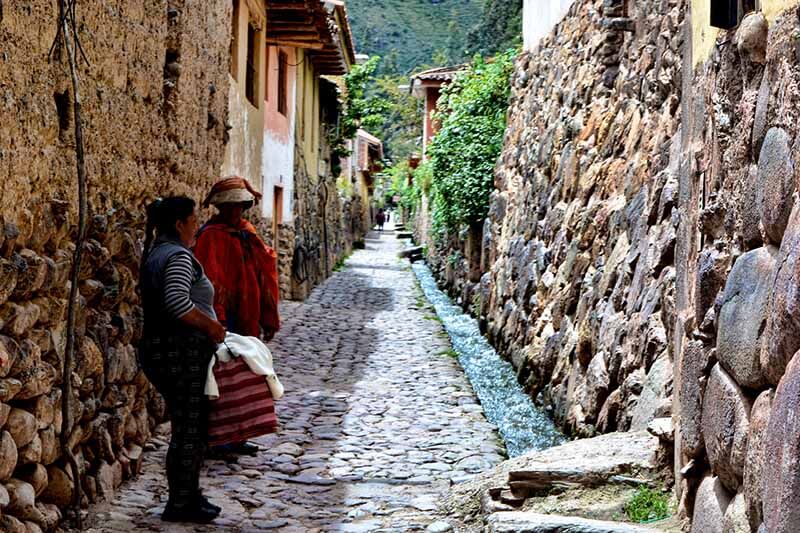
Streets of the Town of Ollantaytambo
Archaeological site of Pinkuylluna
The Pinkuylluna warehouses are one of the lesser-known attractions of Ollantaytambo and Cusco. They are in the middle of a steep mountain. From there you can see the whole town as a beautiful landscape.
- From any part of the town you can see some Inca constructions in the form of houses located in the narrowness of the mountain.
- These Inca structures are known as The Pinkuylluna warehouses. The Incas built these deposits to store various products such as corn, potatoes, coca and more.
- From the Pinkuylluna you can see the whole town and its surroundings. The Incas built it at that height so that the climate conserves food better.
How to get to Pinkuylluna? You can get there on foot. Only follow the road of the street ‘Qosqo Ayllu’ from the Main Square. The journey takes 20 or 30 minutes.
Perolniyoc Waterfalls
Ollantaytambo also offers adventure tourist attractions. The Perolniyoc falls is a natural attraction that includes a short trekking route.
- The Perolniyoc falls are a very beautiful natural attraction located on the outskirts of Ollantaytambo. You can get there on your own or through an adventure tour.
- The waterfalls have a waterfall of more than 100 meters in height. The beauty of the place is one of the favorite attractions of the locals.
- You do not need to buy an entrance ticket to visit the Perolniyoc Falls. You only need to get to the place and enjoy the beauty of the landscape.
How to get to the falls? Perolniyoc is located 30 minutes on foot from the village of Socma. You can get there by a short car trip from Ollantaytambo.
The Yanacocha lagoon
The Yanacocha lagoon is a natural attraction of great popularity in the towns around Ollantaytambo. The trekking route to this lake is also an incredible tourist activity.
- Yanacocha means ‘Black Lagoon’. This natural attraction is close to the town of Huayabamba (only 26 kilometers from Ollantaytambo).
- The color of the waters of this lagoon is black. The diameter of the lake is 240 meters. The depth, of 14 meters. The place is surrounded by a set of mountains.
- Many tourists decide to camp near the lagoon. The place is also ideal to take very good pictures.
How to get to the Yanacocha lagoon? The only way to get there is on foot. The journey begins in Huayabamba. The road takes 4 hours approximately. The income is free.
Experiential tourism in Ollantaytambo
One of the new activities in Ollantaytambo is the experiential tourism in the community of Willoq. This town preserves many of the ancient Andean traditions.
- The community of Willoq is located 45 minutes by car from Ollantaytambo. This small town is visited by tourists since 1992.
- The main customs in Willoq include the cultivation of earth and the techniques of ancestral weaving.
- There, tourists can also learn more about the lifestyle of the peasant communities of Cusco as well as their problems and joys.
How to do experiential tourism in Ollantaytambo? There are several tourist agencies that carry out this activity in Willoq. Through the internet you can get in touch and get more information.
Inca Trail
Ollantaytambo is a must to get to Machu Picchu by train and also through the Inca Trail. This 4-day walk is considered one of the best in the world.
- The starting point to the Inca Trail is at kilometer 82 of the railway that leads to Machu Picchu. From Ollantaytambo are 15 kilometers by car (33 minutes).
- From there, tourists travel a total distance of 39.6 kilometers through ancient Inca trails to reach Machu Picchu on the morning of day 4.
- During the tour, tourists will appreciate other Inca archaeological sites such as Patallacta, Q’ente, Wiñaywayna and many more.
How to make the Inca Trail? You can only do the Inca Trail by hiring the services of a tourism agency (online). The reservation must be made 4 or 6 months in advance.
By Ticket Machu Picchu – Last updated, August 15, 2024
The post What to do in Ollantaytambo? first appeared on Ticket Machu Picchu.
]]>The post How to get to Ollantaytambo? first appeared on Ticket Machu Picchu.
]]>- Is it worth visiting Ollantaytambo?
- Where is Ollantaytambo located?
- How do I get from Cusco to Ollantaytambo?
- How much does it cost to get to Ollantaytambo?
- How to get to Machu Picchu from Ollantaytambo?
- What to see in Ollantaytambo?
- What to do in Ollantaytambo?
- Where to sleep in Ollantaytambo?
- What to eat in Ollantaytambo?
- Useful information about Ollantaytambo
- Questions and answers about the trip to Ollantaytambo
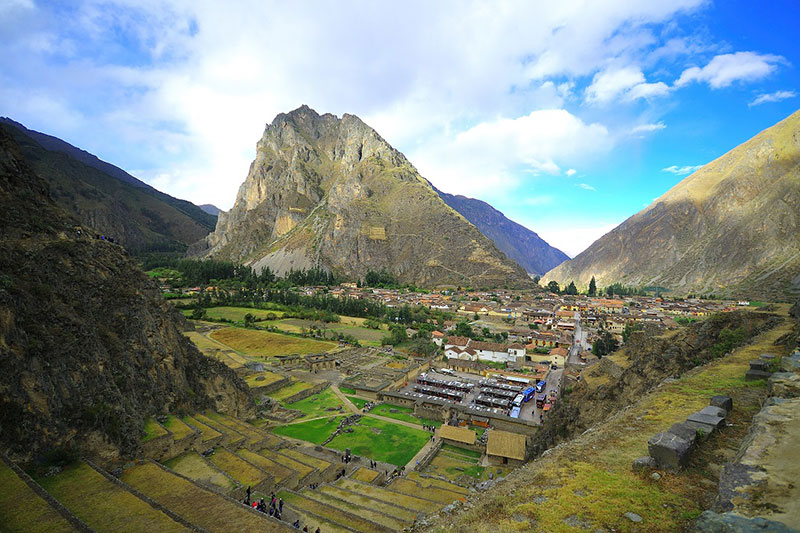
Ollantaytambo necessary step to get to Machu Picchu
Is it worth visiting Ollantaytambo?
- Ollantaytambo was a ceremonial center during the time of the Incas. This historic place served as a checkpoint for people who toured the Sacred Valley of the Incas.
- It also served as an operations center during the Inca resistance at the time of the Spanish invasion.
- Today, Ollantaytambo is considered one of the most impressive places in South America. Its Inca urban design has been preserved since the 13th century.
- Its archaeological site has incredible constructions such as Machu Picchu. There are restaurants and first class hotels there.
Where is Ollantaytambo located?
- Ollantaytambo is located in the Sacred Valley of the Incas, in the current province of Urubamba (Cusco).
- It is located 2,792 meters above sea level (msnm), almost 60 kilometers from the city of Cusco.
- The town sits next to the Urubamba River. From this town, trains depart in the direction of Aguas Calientes (Machu Picchu town).
How do I get from Cusco to Ollantaytambo?
- There are 2 ways to get to Ollantaytambo: one to the north through the town of Pisac and another shorter to the south, through the town of Chinchero.
- Otra de las formas que los turistas utilizan es contratar los servicios de una agencia de turismo que los transporte desde la ciudad del Cusco hasta la estación de tren Ollantaytambo.
By the route Pisac:
- To travel this route you must take the buses on Puputi S / N street in Cusco. The cars pass through the town of Pisac and arrive in Calca. The trip takes approximately 1 hour and 20 minutes.
- After Calca, you should take a car to the town of Urubamba (30 minutes).
- Finally, you must board a bus from Urubamba to the town of Ollantaytambo (30 minutes).
By the route Chinchero:
- To travel with this last route, you must board the small buses on Pavitos street in Cusco
- These cars reach the Main Plaza of Ollantaytambo (with an intermediate stop in the town of Urubamba). The trip takes approximately 1 hour and 30 minutes.
- You can get to Ollantaytambo by train. However, the cost may be somewhat high for most people.
- If you are in one of the towns of the Sacred Valley, you can take the buses to ‘Ollanta’.
With a tourism agency:
- To travel with a tourism agency you must purchase a Cusco – Ollantaytambo transportation service.
- These services pick you up directly at the door of your hotel to transport you without stopping to the same train station.
- There are 2 types of service: shared (with other tourists who contracted the same service) or private (exclusive for a couple, group of friends or family).
- After visiting Machu Picchu, the tourist can also choose the return service: from Ollantaytambo to Cusco.
- The prices are higher than doing it on your own. However, many tourists choose this service because it is safe and organized.
How much does it cost to get to Ollantaytambo?
Getting to Ollantaytambo is not expensive. The cheapest way to get there is by the short route (Chinchero route).
How much does it cost to get to Ollantaytambo by the Chinchero route?
| How to get to Ollantaytambo? | Price in american dollars |
| From Cusco to Ollantaytambo by Chinchero | 4 dollars |
| Total cost | 4 dollars |
How much does it cost to get to Ollantaytambo by the Pisac route?
| How to get to Ollantaytambo? | Price in american dollars |
| From Cusco to Calca on the Pisac route | 2 dollars |
| From Calca to Urubamba | 2 dollars |
| From Urubamba to Ollantaytambo | 2 dollars |
| Total cost | 6 dollars |
How much does it cost to get to Ollantaytambo with a tourism agency?
| How to get to Ollantaytambo? | Price (approximate) in US dollars |
| In shared service | 11 dollars |
| In private service (for 3 tourists) | 48 dollars |
How to get to Machu Picchu from Ollantaytambo?
- In Ollantaytambo there is the train station from where most tourists depart in the direction of Machu Picchu.
- The train trip lasts approximately 2 hours (30.5 kilometers away). The final destination is the town of Aguas Calientes.
- In Aguas Calientes (also called Machu Picchu town) the buses leave in 30 minutes to ascend a steep mountain to the entrance gate to the Wonder of the World (9 kilometers away).
Train tickets (from Ollantaytambo to Machu Picchu) must be booked online and in advance.
Other routes to Machu Picchu
- Inca Trail: Only 15 kilometers from Ollantaytambo is the ‘Km 82’, the starting point of the famous Inca Trail. This adventure takes us to Machu Picchu in 4 days and 3 nights. It is considered one of the 5 best hiking trails in the world. Tickets must be booked online and months in advance.
- Route through Santa María: 119 kilometers from Ollantaytambo (2 hours by car) is the town of Santa María. From this place you get to Machu Picchu by the so-called ‘Hidroeléctrica’ route. This alternative path is longer but it includes hikes and adventures.
What to see in Ollantaytambo?
Ollantaytambo is magical. It conserves the straight streets of the Inca period. Where the inhabitants live today you can see the Inca walls of the original houses.
On one side of these small streets you can see Inca channels that currently supply the town with crystal clear waters. There you will feel at times that you go back hundreds of years to the past.
-
Archaeological site of Ollantaytambo
Ollantaytambo was a ‘tampu‘ (hostel) for the Inca nobility. After the Spanish invasion the town was rebuilt on the original layout. Among the most impressive structures of the enclosure you can see the Sun Temple.
-
The town of Ollantaytambo
In the town of Ollantaytambo you can enjoy its streets, its landscapes and its people. In your square you can observe the locals coming down from nearby communities with colorful traditional costumes and hats adorned with multicolored flowers.
-
The Pincuylluna hill
The Pincuylluna hill is located in front of the Temple of the Sun of the Ollantaytambo fortress. If you decide to climb the mountain, you can see structures of stone blocks superimposed with 6 windows of facades and 6 windows called ‘colcas’ (Inca warehouses).
-
Site Museum of “CATCCO”
CATCCO is the abbreviation of “Andean Center of Traditional Technology and Culture of the Communities of Ollantaytambo”. There are exhibited samples of architecture, craftsmanship and beliefs of the villagers.

Temple of the Sun Ollantaytambo
What to do in Ollantaytambo?
-
Mountain biking
Try mountain biking at the Abra Málaga. There it will descend around 1,500 m. (5,000 ft.) There you will get exceptional views on a tour that has been described by many as one of the most beautiful in South America.
-
Horse riding tours to Inti Punku in Ollantaytambo
In Ollantaytambo you can also take a horse and go to the Inti Punku viewpoint (Puerta del Sol). In the tour you will see archaeological sites and you can learn more about the Inca culture. The tour lasts around 8 hours round trip.
Where to sleep in Ollantaytambo?
- Ollantaytambo is a must to get to Machu Picchu, which is why a medium-sized tourist plant has been developed. There you can find hotels from 1 to 4 stars.
- If you wish, you can spend the night in Ollantaytambo after visiting the Sacred Valley of the Incas and, the next day, you can take the train to Machu Picchu.
What to eat in Ollantaytambo?
- In Ollantaytambo, there are more than 50 restaurants of different categories where you can have breakfast, lunch and dinner.
- They have pizzerias, bars, coffee-bars, restaurants of Peruvian food and others. All establishments serve quality food.
Interesting information about Ollantaytambo
- Ollantay… what? The correct pronunciation is /Oy-yahn-tie-tahm-bo/ . It can be difficult at first. However, once mastered it will sound quite good. The places simply say “Ollanta” /Oy-yahn-ta/.
- Ollantaytambo is called ‘Fortress’ because a tough battle between the rebel Incas and the Spanish invaders was fought there in 1537 .
- Ollantaytambo is the scene of a drama of unknown Quechua origin. According to history, the Inca general Ollantay is punished for wanting to marry the daughter of the Inca Pachacutec.
- Currently, Ollantaytambo celebrates the Ollantay Raymi Festival, a staging of the drama ‘Ollantay’. The staging is in Inca archaeological sites and takes place at the end of June.
Questions and answers about the trip to Ollantaytambo
-
1) How much does it cost to get to Ollantaytambo by public transport?
The minivan trip from Cusco to Ollantaytambo costs 10 soles per person. The same trip by collective taxi costs 15 soles per person. The prices are referential.
-
2) How long does it take to get from Cusco to Ollantaytambo?
The trip takes 1 hour 40 minutes on average.
-
3) Where do you take the buses that go to Ollantaytambo?
Minivans and collective taxis are boarded on Pavitos street in the historic center of Cusco.
-
4) Where is the Ollantaytambo train station?
The train station is located in the lower part of the town of Ollantaytambo. All transportation services from Cusco to Ollantaytambo drop you off there.
-
5) Are there cars for Ollantaytambo on Sundays?
Yes, every day of the week the minivans and collective taxis leave from Cusco and go to Ollantaytambo.
-
6) How much does a collective taxi cost from Cusco to Ollantaytambo?
On Pavitos street in the city of Cusco there are minivans and collective taxis that drive you to Ollantaytambo. The collective taxi takes you for a cost of 15 soles per person.
-
7) Is the trip to Ollantaytambo safe?
Yes, the trip from Cusco to Ollantaytambo is through a safe paved road. Few accidents happen there. In addition, the trip takes only 1 hour 40 minutes.
-
8) What time do the first cars leave for Ollantaytambo?
The cars that depart for Ollantaytambo are available from 3:30 in the morning on Pavitos street in the city of Cusco.
-
9) Can I get from Cusco to Ollantaytambo by train?
Although this trip is not very common, it is possible to go from Cusco to Ollantaytambo by train (most do it by bus). Most visitors take their train at the Ollantaytambo station. It is also possible to travel by train directly from Cusco to Machu Picchu passing through Ollantaytambo.
-
10) How to get from Urubamba to Ollantaytambo?
The town of Urubamba is only 19 kilometers from Ollantaytambo. This journey can be made by minivan or collective taxi. These services can be obtained on the main road or at the bus stop in Urubamba.
By Ticket Machu Picchu – Last updated, August 15, 2024
The post How to get to Ollantaytambo? first appeared on Ticket Machu Picchu.
]]>

